ACT202: Management Accounting Assignment
VerifiedAdded on 2021/05/31
|24
|2209
|47
AI Summary
Contribute Materials
Your contribution can guide someone’s learning journey. Share your
documents today.
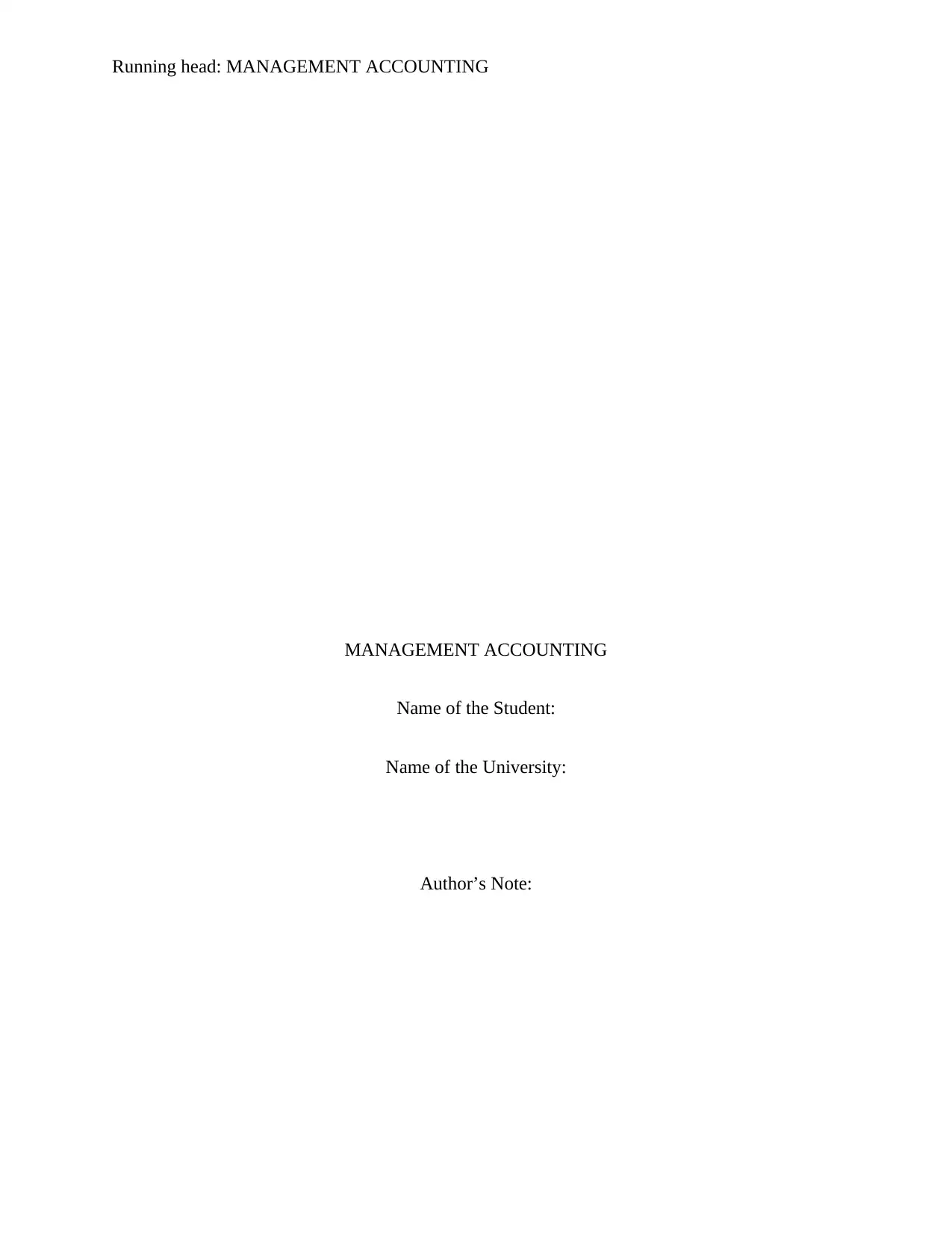
Running head: MANAGEMENT ACCOUNTING
MANAGEMENT ACCOUNTING
Name of the Student:
Name of the University:
Author’s Note:
MANAGEMENT ACCOUNTING
Name of the Student:
Name of the University:
Author’s Note:
Secure Best Marks with AI Grader
Need help grading? Try our AI Grader for instant feedback on your assignments.
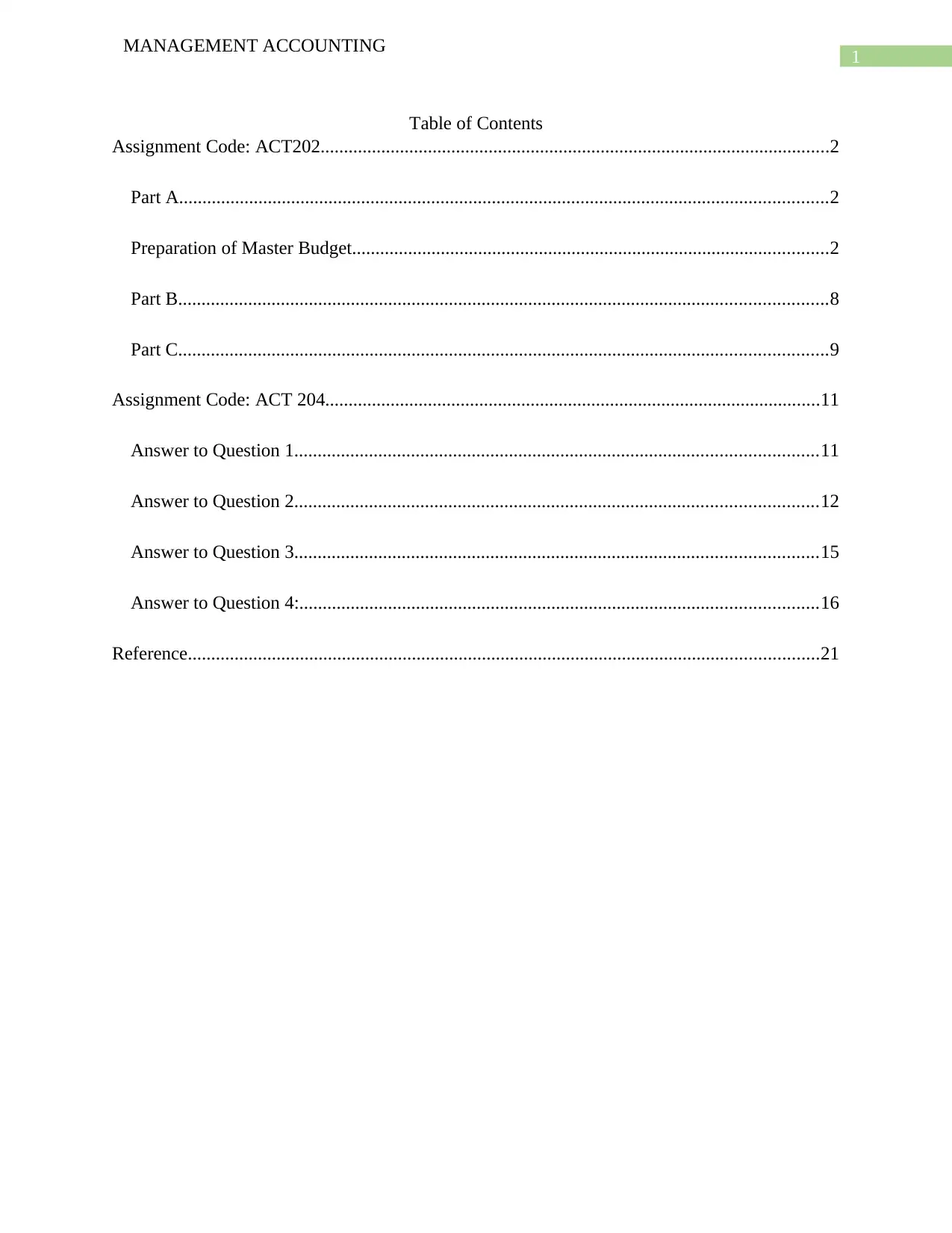
1
MANAGEMENT ACCOUNTING
Table of Contents
Assignment Code: ACT202.............................................................................................................2
Part A...........................................................................................................................................2
Preparation of Master Budget......................................................................................................2
Part B...........................................................................................................................................8
Part C...........................................................................................................................................9
Assignment Code: ACT 204..........................................................................................................11
Answer to Question 1................................................................................................................11
Answer to Question 2................................................................................................................12
Answer to Question 3................................................................................................................15
Answer to Question 4:...............................................................................................................16
Reference.......................................................................................................................................21
MANAGEMENT ACCOUNTING
Table of Contents
Assignment Code: ACT202.............................................................................................................2
Part A...........................................................................................................................................2
Preparation of Master Budget......................................................................................................2
Part B...........................................................................................................................................8
Part C...........................................................................................................................................9
Assignment Code: ACT 204..........................................................................................................11
Answer to Question 1................................................................................................................11
Answer to Question 2................................................................................................................12
Answer to Question 3................................................................................................................15
Answer to Question 4:...............................................................................................................16
Reference.......................................................................................................................................21
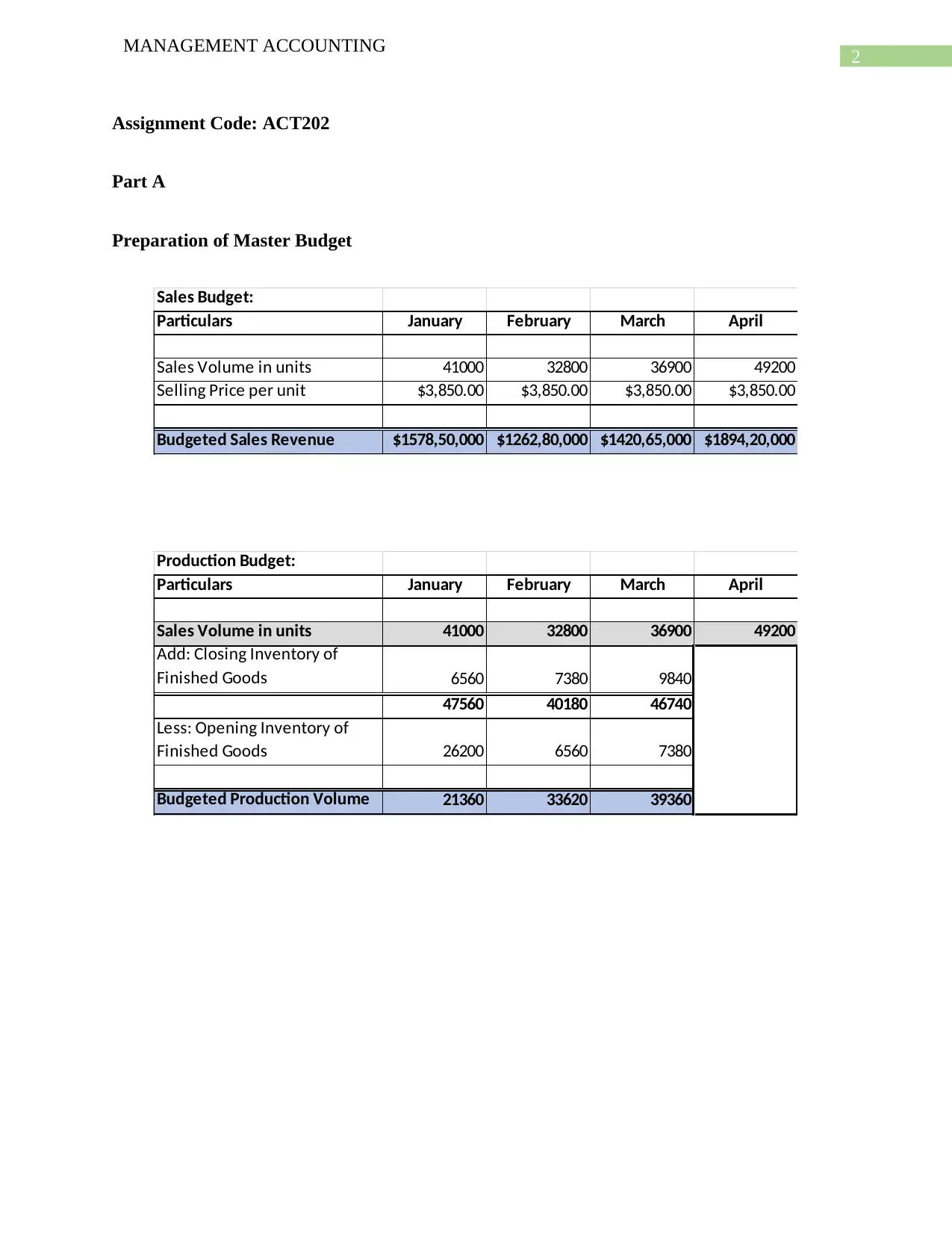
2
MANAGEMENT ACCOUNTING
Assignment Code: ACT202
Part A
Preparation of Master Budget
Sales Budget:
Particulars January February March April
Sales Volume in units 41000 32800 36900 49200
Selling Price per unit $3,850.00 $3,850.00 $3,850.00 $3,850.00
Budgeted Sales Revenue $1578,50,000 $1262,80,000 $1420,65,000 $1894,20,000
Production Budget:
Particulars January February March April
Sales Volume in units 41000 32800 36900 49200
Add: Closing Inventory of
Finished Goods 6560 7380 9840
47560 40180 46740
Less: Opening Inventory of
Finished Goods 26200 6560 7380
Budgeted Production Volume 21360 33620 39360
MANAGEMENT ACCOUNTING
Assignment Code: ACT202
Part A
Preparation of Master Budget
Sales Budget:
Particulars January February March April
Sales Volume in units 41000 32800 36900 49200
Selling Price per unit $3,850.00 $3,850.00 $3,850.00 $3,850.00
Budgeted Sales Revenue $1578,50,000 $1262,80,000 $1420,65,000 $1894,20,000
Production Budget:
Particulars January February March April
Sales Volume in units 41000 32800 36900 49200
Add: Closing Inventory of
Finished Goods 6560 7380 9840
47560 40180 46740
Less: Opening Inventory of
Finished Goods 26200 6560 7380
Budgeted Production Volume 21360 33620 39360
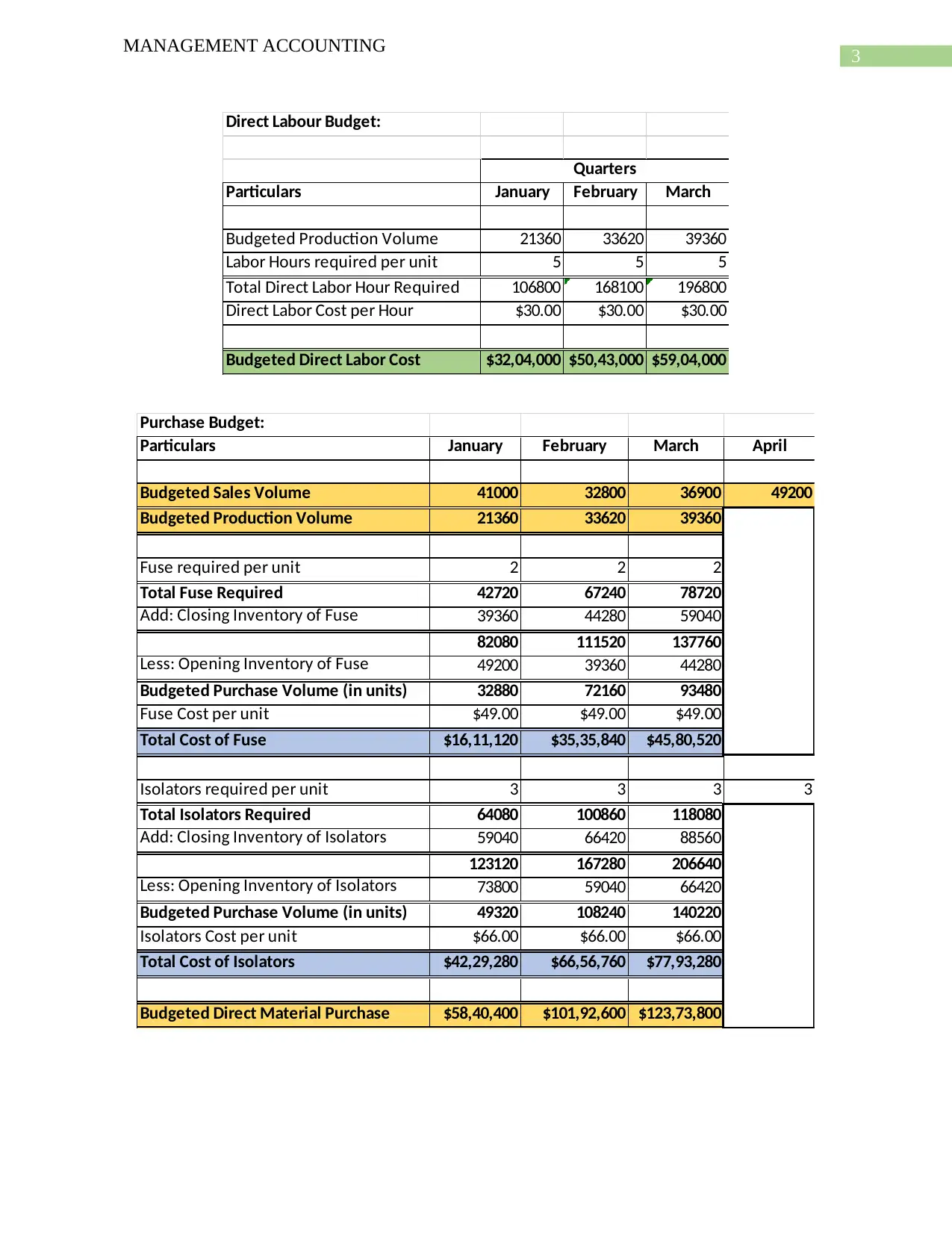
3
MANAGEMENT ACCOUNTING
Direct Labour Budget:
Particulars January February March
Budgeted Production Volume 21360 33620 39360
Labor Hours required per unit 5 5 5
Total Direct Labor Hour Required 106800 168100 196800
Direct Labor Cost per Hour $30.00 $30.00 $30.00
Budgeted Direct Labor Cost $32,04,000 $50,43,000 $59,04,000
Quarters
Purchase Budget:
Particulars January February March April
Budgeted Sales Volume 41000 32800 36900 49200
Budgeted Production Volume 21360 33620 39360
Fuse required per unit 2 2 2
Total Fuse Required 42720 67240 78720
Add: Closing Inventory of Fuse 39360 44280 59040
82080 111520 137760
Less: Opening Inventory of Fuse 49200 39360 44280
Budgeted Purchase Volume (in units) 32880 72160 93480
Fuse Cost per unit $49.00 $49.00 $49.00
Total Cost of Fuse $16,11,120 $35,35,840 $45,80,520
Isolators required per unit 3 3 3 3
Total Isolators Required 64080 100860 118080
Add: Closing Inventory of Isolators 59040 66420 88560
123120 167280 206640
Less: Opening Inventory of Isolators 73800 59040 66420
Budgeted Purchase Volume (in units) 49320 108240 140220
Isolators Cost per unit $66.00 $66.00 $66.00
Total Cost of Isolators $42,29,280 $66,56,760 $77,93,280
Budgeted Direct Material Purchase $58,40,400 $101,92,600 $123,73,800
MANAGEMENT ACCOUNTING
Direct Labour Budget:
Particulars January February March
Budgeted Production Volume 21360 33620 39360
Labor Hours required per unit 5 5 5
Total Direct Labor Hour Required 106800 168100 196800
Direct Labor Cost per Hour $30.00 $30.00 $30.00
Budgeted Direct Labor Cost $32,04,000 $50,43,000 $59,04,000
Quarters
Purchase Budget:
Particulars January February March April
Budgeted Sales Volume 41000 32800 36900 49200
Budgeted Production Volume 21360 33620 39360
Fuse required per unit 2 2 2
Total Fuse Required 42720 67240 78720
Add: Closing Inventory of Fuse 39360 44280 59040
82080 111520 137760
Less: Opening Inventory of Fuse 49200 39360 44280
Budgeted Purchase Volume (in units) 32880 72160 93480
Fuse Cost per unit $49.00 $49.00 $49.00
Total Cost of Fuse $16,11,120 $35,35,840 $45,80,520
Isolators required per unit 3 3 3 3
Total Isolators Required 64080 100860 118080
Add: Closing Inventory of Isolators 59040 66420 88560
123120 167280 206640
Less: Opening Inventory of Isolators 73800 59040 66420
Budgeted Purchase Volume (in units) 49320 108240 140220
Isolators Cost per unit $66.00 $66.00 $66.00
Total Cost of Isolators $42,29,280 $66,56,760 $77,93,280
Budgeted Direct Material Purchase $58,40,400 $101,92,600 $123,73,800
Secure Best Marks with AI Grader
Need help grading? Try our AI Grader for instant feedback on your assignments.
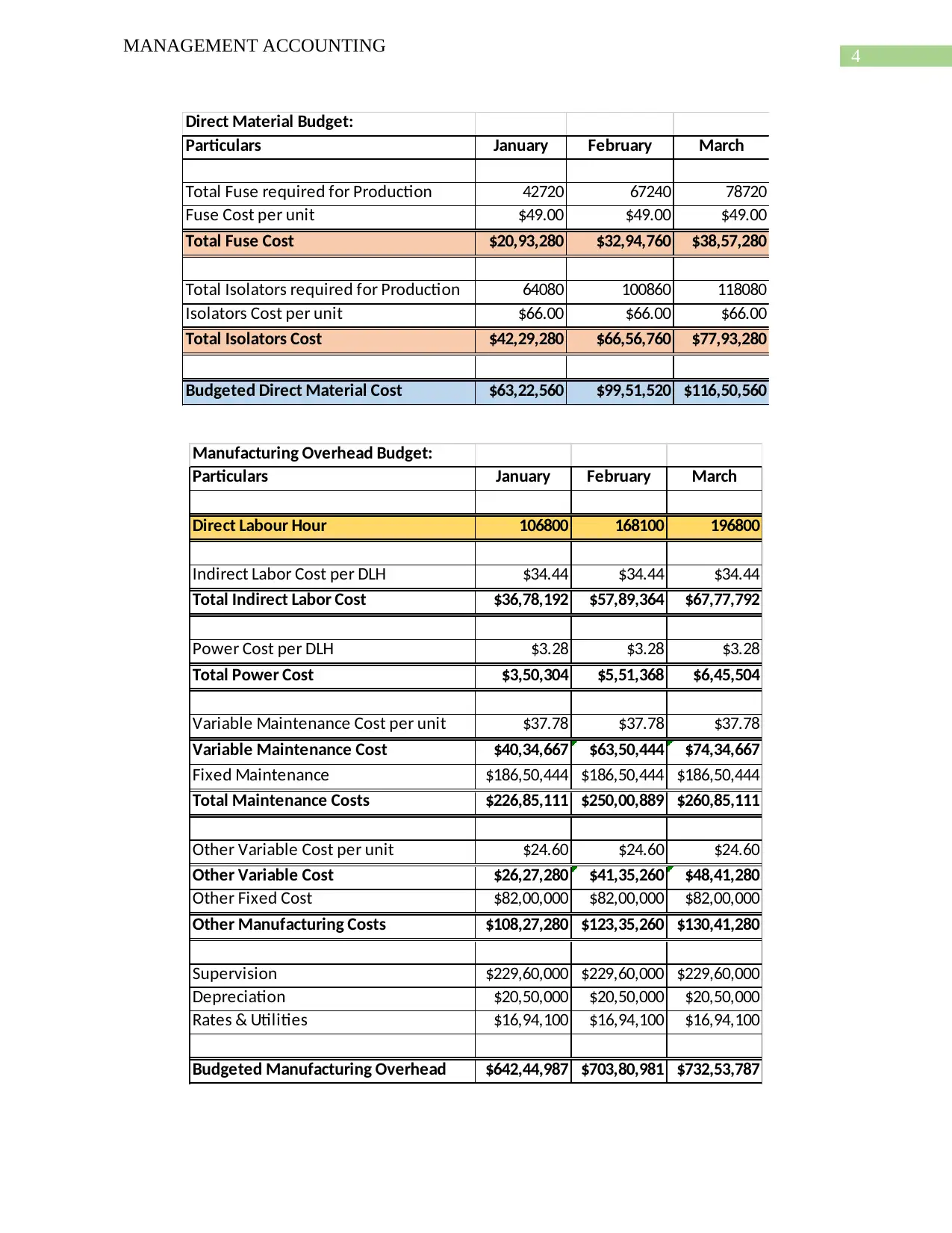
4
MANAGEMENT ACCOUNTING
Direct Material Budget:
Particulars January February March
Total Fuse required for Production 42720 67240 78720
Fuse Cost per unit $49.00 $49.00 $49.00
Total Fuse Cost $20,93,280 $32,94,760 $38,57,280
Total Isolators required for Production 64080 100860 118080
Isolators Cost per unit $66.00 $66.00 $66.00
Total Isolators Cost $42,29,280 $66,56,760 $77,93,280
Budgeted Direct Material Cost $63,22,560 $99,51,520 $116,50,560
Manufacturing Overhead Budget:
Particulars January February March
Direct Labour Hour 106800 168100 196800
Indirect Labor Cost per DLH $34.44 $34.44 $34.44
Total Indirect Labor Cost $36,78,192 $57,89,364 $67,77,792
Power Cost per DLH $3.28 $3.28 $3.28
Total Power Cost $3,50,304 $5,51,368 $6,45,504
Variable Maintenance Cost per unit $37.78 $37.78 $37.78
Variable Maintenance Cost $40,34,667 $63,50,444 $74,34,667
Fixed Maintenance $186,50,444 $186,50,444 $186,50,444
Total Maintenance Costs $226,85,111 $250,00,889 $260,85,111
Other Variable Cost per unit $24.60 $24.60 $24.60
Other Variable Cost $26,27,280 $41,35,260 $48,41,280
Other Fixed Cost $82,00,000 $82,00,000 $82,00,000
Other Manufacturing Costs $108,27,280 $123,35,260 $130,41,280
Supervision $229,60,000 $229,60,000 $229,60,000
Depreciation $20,50,000 $20,50,000 $20,50,000
Rates & Utilities $16,94,100 $16,94,100 $16,94,100
Budgeted Manufacturing Overhead $642,44,987 $703,80,981 $732,53,787
MANAGEMENT ACCOUNTING
Direct Material Budget:
Particulars January February March
Total Fuse required for Production 42720 67240 78720
Fuse Cost per unit $49.00 $49.00 $49.00
Total Fuse Cost $20,93,280 $32,94,760 $38,57,280
Total Isolators required for Production 64080 100860 118080
Isolators Cost per unit $66.00 $66.00 $66.00
Total Isolators Cost $42,29,280 $66,56,760 $77,93,280
Budgeted Direct Material Cost $63,22,560 $99,51,520 $116,50,560
Manufacturing Overhead Budget:
Particulars January February March
Direct Labour Hour 106800 168100 196800
Indirect Labor Cost per DLH $34.44 $34.44 $34.44
Total Indirect Labor Cost $36,78,192 $57,89,364 $67,77,792
Power Cost per DLH $3.28 $3.28 $3.28
Total Power Cost $3,50,304 $5,51,368 $6,45,504
Variable Maintenance Cost per unit $37.78 $37.78 $37.78
Variable Maintenance Cost $40,34,667 $63,50,444 $74,34,667
Fixed Maintenance $186,50,444 $186,50,444 $186,50,444
Total Maintenance Costs $226,85,111 $250,00,889 $260,85,111
Other Variable Cost per unit $24.60 $24.60 $24.60
Other Variable Cost $26,27,280 $41,35,260 $48,41,280
Other Fixed Cost $82,00,000 $82,00,000 $82,00,000
Other Manufacturing Costs $108,27,280 $123,35,260 $130,41,280
Supervision $229,60,000 $229,60,000 $229,60,000
Depreciation $20,50,000 $20,50,000 $20,50,000
Rates & Utilities $16,94,100 $16,94,100 $16,94,100
Budgeted Manufacturing Overhead $642,44,987 $703,80,981 $732,53,787

5
MANAGEMENT ACCOUNTING
Cash Collection from Debtors:
Particulars January February March
Total Sales Revenue $1578,50,000 $1262,80,000 $1420,65,000
Collection in the month of Sales $315,70,000 $252,56,000 $284,13,000
Collection in the following month of
Sales $1056,39,300 $1231,23,000 $984,98,400
Total Collection from Debtors $1372,09,300 $1483,79,000 $1269,11,400
Cash Payment of Selling & Administration Expenses:
Particulars January February March
Toatl Selling & Administrative Expenses $384,37,500 $307,50,000 $345,93,750
Due from Debtors $1354,35,000 $1578,50,000 $1262,80,000
Bad Debts @2% -$27,08,700 -$31,57,000 -$25,25,600
Cash Payment for Selling &
Administration Expenses $357,28,800 $275,93,000 $320,68,150
MANAGEMENT ACCOUNTING
Cash Collection from Debtors:
Particulars January February March
Total Sales Revenue $1578,50,000 $1262,80,000 $1420,65,000
Collection in the month of Sales $315,70,000 $252,56,000 $284,13,000
Collection in the following month of
Sales $1056,39,300 $1231,23,000 $984,98,400
Total Collection from Debtors $1372,09,300 $1483,79,000 $1269,11,400
Cash Payment of Selling & Administration Expenses:
Particulars January February March
Toatl Selling & Administrative Expenses $384,37,500 $307,50,000 $345,93,750
Due from Debtors $1354,35,000 $1578,50,000 $1262,80,000
Bad Debts @2% -$27,08,700 -$31,57,000 -$25,25,600
Cash Payment for Selling &
Administration Expenses $357,28,800 $275,93,000 $320,68,150

6
MANAGEMENT ACCOUNTING
Cash Budget:
Particulars January February March TOTAL
Cash Flow from Operational Activities:
Collection from Debtors $1372,09,300 $1483,79,000 $1269,11,400 $4124,99,700
Payment to Suppliers -$58,40,400 -$101,92,600 -$123,73,800 -$284,06,800
Direct Labour Cost Paid -$32,04,000 -$50,43,000 -$59,04,000 -$141,51,000
Indirect Labor Cost -$36,78,192 -$57,89,364 -$67,77,792 -$162,45,348
Power Cost -$3,50,304 -$5,51,368 -$6,45,504 -$15,47,176
Maintenance Charges Paid -$226,85,111 -$250,00,889 -$260,85,111 -$737,71,111
Other Manufacturing Cost -$108,27,280 -$123,35,260 -$130,41,280 -$362,03,820
Supervision -$229,60,000 -$229,60,000 -$229,60,000 -$688,80,000
Rates & Utilities -$16,94,100 -$16,94,100 -$16,94,100 -$50,82,300
Selling & Administration Expenses -$357,28,800 -$259,52,600 -$302,22,700 -$919,04,100
Net Cash Flow from Operating Activities $302,41,113 $388,59,819 $72,07,113 $763,08,045
Cash Flow from Investing Activities:
Purchase of Land -$213,20,000 -$213,20,000
Net Cash Flow from Investing Activities $0 -$213,20,000 $0 -$213,20,000
Cash Flow from Financing Activities:
Dividend Paid -$7,25,700 -$7,25,700
Loan from Bank $0
Repayment of Loan $0 $0 $0
Interest Paid $0 $0 $0
Net Cash Flow from Financing Activities -$7,25,700 $0 $0 -$7,25,700
Net Increase/(Decrease) in Cash Flows $295,15,413 $175,39,819 $72,07,113 $542,62,345
Add: Opening Cash Balance $20,50,000 $315,65,413 $491,05,232 $20,50,000
Closing Cash Balance $315,65,413 $491,05,232 $563,12,345 $563,12,345
MANAGEMENT ACCOUNTING
Cash Budget:
Particulars January February March TOTAL
Cash Flow from Operational Activities:
Collection from Debtors $1372,09,300 $1483,79,000 $1269,11,400 $4124,99,700
Payment to Suppliers -$58,40,400 -$101,92,600 -$123,73,800 -$284,06,800
Direct Labour Cost Paid -$32,04,000 -$50,43,000 -$59,04,000 -$141,51,000
Indirect Labor Cost -$36,78,192 -$57,89,364 -$67,77,792 -$162,45,348
Power Cost -$3,50,304 -$5,51,368 -$6,45,504 -$15,47,176
Maintenance Charges Paid -$226,85,111 -$250,00,889 -$260,85,111 -$737,71,111
Other Manufacturing Cost -$108,27,280 -$123,35,260 -$130,41,280 -$362,03,820
Supervision -$229,60,000 -$229,60,000 -$229,60,000 -$688,80,000
Rates & Utilities -$16,94,100 -$16,94,100 -$16,94,100 -$50,82,300
Selling & Administration Expenses -$357,28,800 -$259,52,600 -$302,22,700 -$919,04,100
Net Cash Flow from Operating Activities $302,41,113 $388,59,819 $72,07,113 $763,08,045
Cash Flow from Investing Activities:
Purchase of Land -$213,20,000 -$213,20,000
Net Cash Flow from Investing Activities $0 -$213,20,000 $0 -$213,20,000
Cash Flow from Financing Activities:
Dividend Paid -$7,25,700 -$7,25,700
Loan from Bank $0
Repayment of Loan $0 $0 $0
Interest Paid $0 $0 $0
Net Cash Flow from Financing Activities -$7,25,700 $0 $0 -$7,25,700
Net Increase/(Decrease) in Cash Flows $295,15,413 $175,39,819 $72,07,113 $542,62,345
Add: Opening Cash Balance $20,50,000 $315,65,413 $491,05,232 $20,50,000
Closing Cash Balance $315,65,413 $491,05,232 $563,12,345 $563,12,345
Paraphrase This Document
Need a fresh take? Get an instant paraphrase of this document with our AI Paraphraser
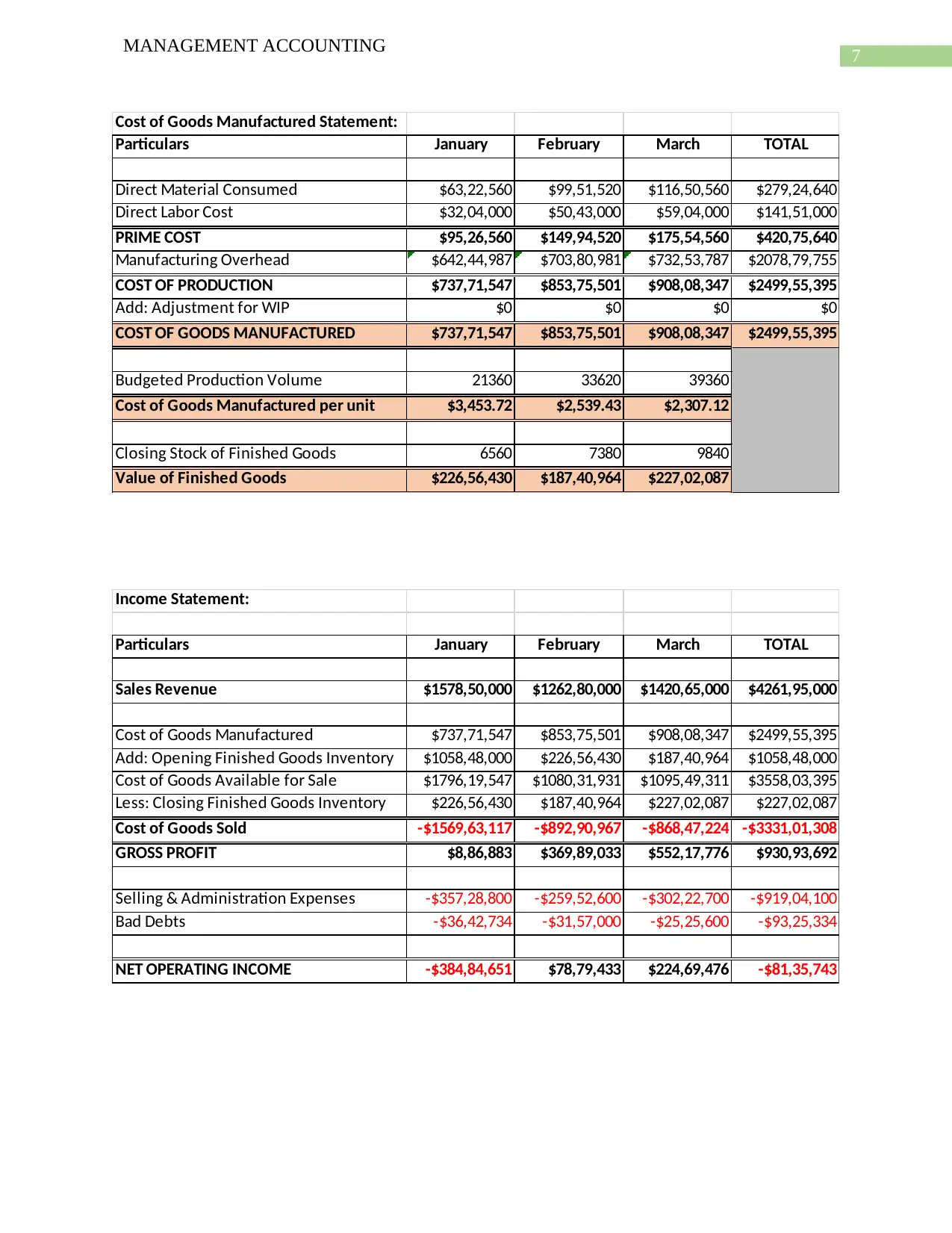
7
MANAGEMENT ACCOUNTING
Cost of Goods Manufactured Statement:
Particulars January February March TOTAL
Direct Material Consumed $63,22,560 $99,51,520 $116,50,560 $279,24,640
Direct Labor Cost $32,04,000 $50,43,000 $59,04,000 $141,51,000
PRIME COST $95,26,560 $149,94,520 $175,54,560 $420,75,640
Manufacturing Overhead $642,44,987 $703,80,981 $732,53,787 $2078,79,755
COST OF PRODUCTION $737,71,547 $853,75,501 $908,08,347 $2499,55,395
Add: Adjustment for WIP $0 $0 $0 $0
COST OF GOODS MANUFACTURED $737,71,547 $853,75,501 $908,08,347 $2499,55,395
Budgeted Production Volume 21360 33620 39360
Cost of Goods Manufactured per unit $3,453.72 $2,539.43 $2,307.12
Closing Stock of Finished Goods 6560 7380 9840
Value of Finished Goods $226,56,430 $187,40,964 $227,02,087
Income Statement:
Particulars January February March TOTAL
Sales Revenue $1578,50,000 $1262,80,000 $1420,65,000 $4261,95,000
Cost of Goods Manufactured $737,71,547 $853,75,501 $908,08,347 $2499,55,395
Add: Opening Finished Goods Inventory $1058,48,000 $226,56,430 $187,40,964 $1058,48,000
Cost of Goods Available for Sale $1796,19,547 $1080,31,931 $1095,49,311 $3558,03,395
Less: Closing Finished Goods Inventory $226,56,430 $187,40,964 $227,02,087 $227,02,087
Cost of Goods Sold -$1569,63,117 -$892,90,967 -$868,47,224 -$3331,01,308
GROSS PROFIT $8,86,883 $369,89,033 $552,17,776 $930,93,692
Selling & Administration Expenses -$357,28,800 -$259,52,600 -$302,22,700 -$919,04,100
Bad Debts -$36,42,734 -$31,57,000 -$25,25,600 -$93,25,334
NET OPERATING INCOME -$384,84,651 $78,79,433 $224,69,476 -$81,35,743
MANAGEMENT ACCOUNTING
Cost of Goods Manufactured Statement:
Particulars January February March TOTAL
Direct Material Consumed $63,22,560 $99,51,520 $116,50,560 $279,24,640
Direct Labor Cost $32,04,000 $50,43,000 $59,04,000 $141,51,000
PRIME COST $95,26,560 $149,94,520 $175,54,560 $420,75,640
Manufacturing Overhead $642,44,987 $703,80,981 $732,53,787 $2078,79,755
COST OF PRODUCTION $737,71,547 $853,75,501 $908,08,347 $2499,55,395
Add: Adjustment for WIP $0 $0 $0 $0
COST OF GOODS MANUFACTURED $737,71,547 $853,75,501 $908,08,347 $2499,55,395
Budgeted Production Volume 21360 33620 39360
Cost of Goods Manufactured per unit $3,453.72 $2,539.43 $2,307.12
Closing Stock of Finished Goods 6560 7380 9840
Value of Finished Goods $226,56,430 $187,40,964 $227,02,087
Income Statement:
Particulars January February March TOTAL
Sales Revenue $1578,50,000 $1262,80,000 $1420,65,000 $4261,95,000
Cost of Goods Manufactured $737,71,547 $853,75,501 $908,08,347 $2499,55,395
Add: Opening Finished Goods Inventory $1058,48,000 $226,56,430 $187,40,964 $1058,48,000
Cost of Goods Available for Sale $1796,19,547 $1080,31,931 $1095,49,311 $3558,03,395
Less: Closing Finished Goods Inventory $226,56,430 $187,40,964 $227,02,087 $227,02,087
Cost of Goods Sold -$1569,63,117 -$892,90,967 -$868,47,224 -$3331,01,308
GROSS PROFIT $8,86,883 $369,89,033 $552,17,776 $930,93,692
Selling & Administration Expenses -$357,28,800 -$259,52,600 -$302,22,700 -$919,04,100
Bad Debts -$36,42,734 -$31,57,000 -$25,25,600 -$93,25,334
NET OPERATING INCOME -$384,84,651 $78,79,433 $224,69,476 -$81,35,743
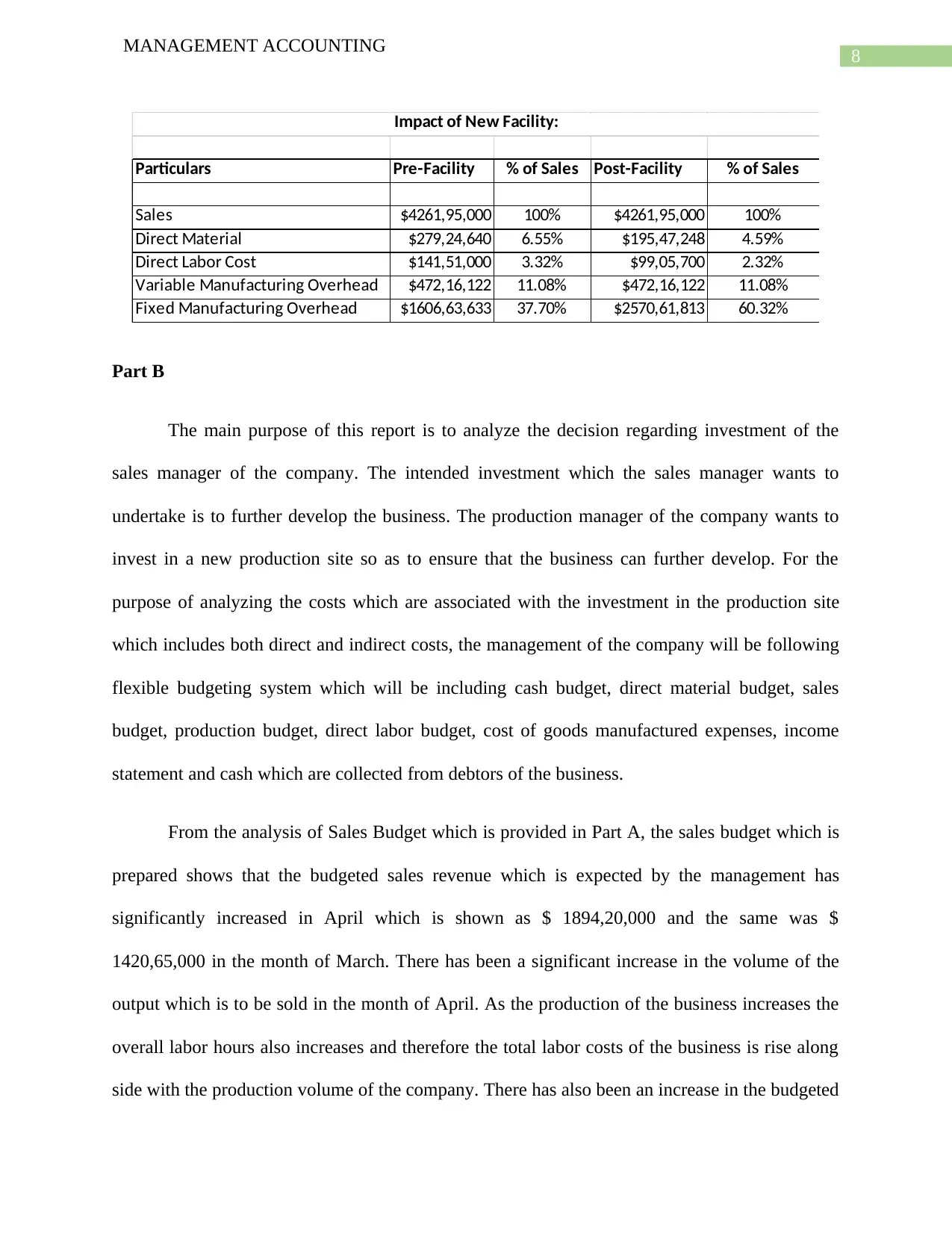
8
MANAGEMENT ACCOUNTING
Particulars Pre-Facility % of Sales Post-Facility % of Sales
Sales $4261,95,000 100% $4261,95,000 100%
Direct Material $279,24,640 6.55% $195,47,248 4.59%
Direct Labor Cost $141,51,000 3.32% $99,05,700 2.32%
Variable Manufacturing Overhead $472,16,122 11.08% $472,16,122 11.08%
Fixed Manufacturing Overhead $1606,63,633 37.70% $2570,61,813 60.32%
Impact of New Facility:
Part B
The main purpose of this report is to analyze the decision regarding investment of the
sales manager of the company. The intended investment which the sales manager wants to
undertake is to further develop the business. The production manager of the company wants to
invest in a new production site so as to ensure that the business can further develop. For the
purpose of analyzing the costs which are associated with the investment in the production site
which includes both direct and indirect costs, the management of the company will be following
flexible budgeting system which will be including cash budget, direct material budget, sales
budget, production budget, direct labor budget, cost of goods manufactured expenses, income
statement and cash which are collected from debtors of the business.
From the analysis of Sales Budget which is provided in Part A, the sales budget which is
prepared shows that the budgeted sales revenue which is expected by the management has
significantly increased in April which is shown as $ 1894,20,000 and the same was $
1420,65,000 in the month of March. There has been a significant increase in the volume of the
output which is to be sold in the month of April. As the production of the business increases the
overall labor hours also increases and therefore the total labor costs of the business is rise along
side with the production volume of the company. There has also been an increase in the budgeted
MANAGEMENT ACCOUNTING
Particulars Pre-Facility % of Sales Post-Facility % of Sales
Sales $4261,95,000 100% $4261,95,000 100%
Direct Material $279,24,640 6.55% $195,47,248 4.59%
Direct Labor Cost $141,51,000 3.32% $99,05,700 2.32%
Variable Manufacturing Overhead $472,16,122 11.08% $472,16,122 11.08%
Fixed Manufacturing Overhead $1606,63,633 37.70% $2570,61,813 60.32%
Impact of New Facility:
Part B
The main purpose of this report is to analyze the decision regarding investment of the
sales manager of the company. The intended investment which the sales manager wants to
undertake is to further develop the business. The production manager of the company wants to
invest in a new production site so as to ensure that the business can further develop. For the
purpose of analyzing the costs which are associated with the investment in the production site
which includes both direct and indirect costs, the management of the company will be following
flexible budgeting system which will be including cash budget, direct material budget, sales
budget, production budget, direct labor budget, cost of goods manufactured expenses, income
statement and cash which are collected from debtors of the business.
From the analysis of Sales Budget which is provided in Part A, the sales budget which is
prepared shows that the budgeted sales revenue which is expected by the management has
significantly increased in April which is shown as $ 1894,20,000 and the same was $
1420,65,000 in the month of March. There has been a significant increase in the volume of the
output which is to be sold in the month of April. As the production of the business increases the
overall labor hours also increases and therefore the total labor costs of the business is rise along
side with the production volume of the company. There has also been an increase in the budgeted
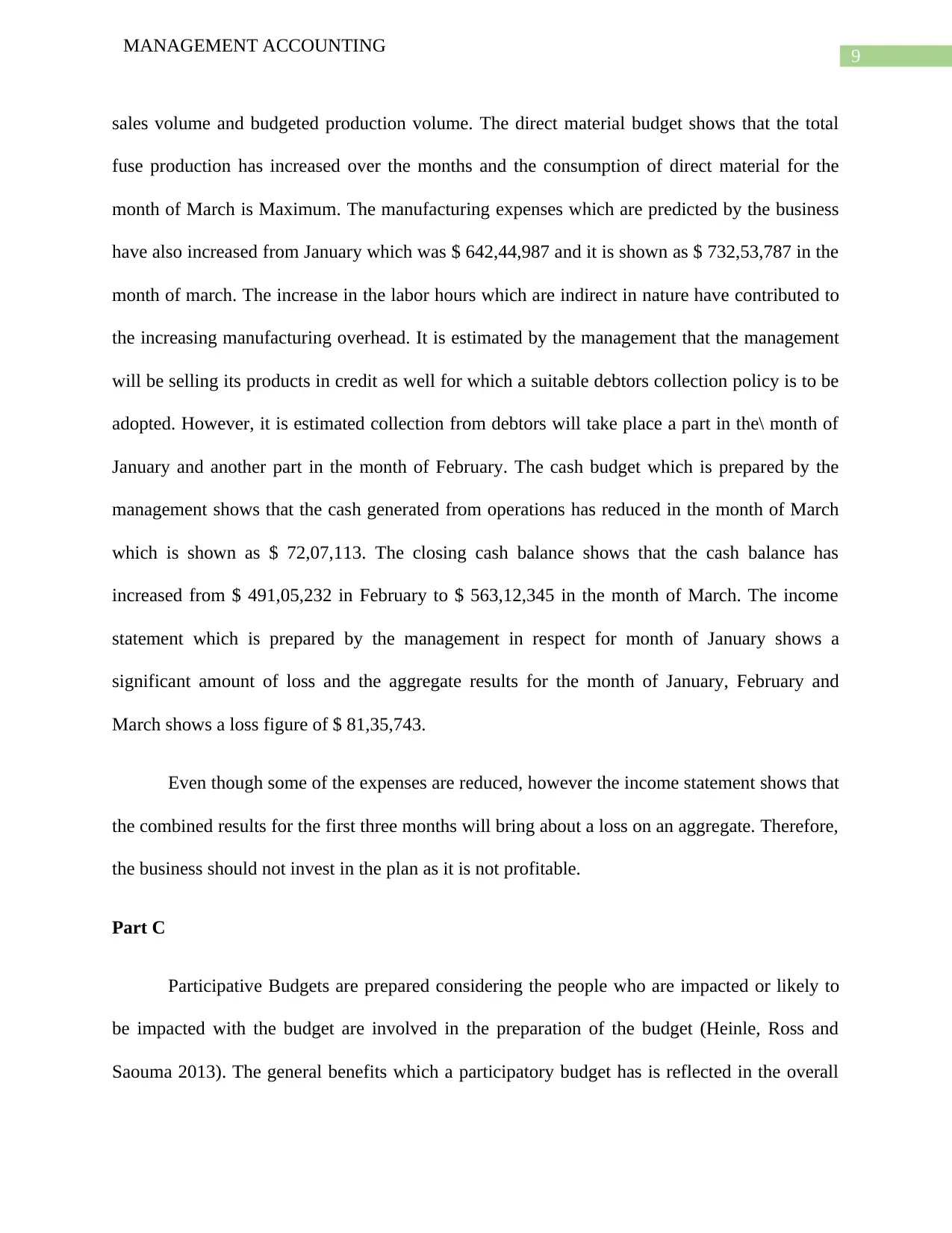
9
MANAGEMENT ACCOUNTING
sales volume and budgeted production volume. The direct material budget shows that the total
fuse production has increased over the months and the consumption of direct material for the
month of March is Maximum. The manufacturing expenses which are predicted by the business
have also increased from January which was $ 642,44,987 and it is shown as $ 732,53,787 in the
month of march. The increase in the labor hours which are indirect in nature have contributed to
the increasing manufacturing overhead. It is estimated by the management that the management
will be selling its products in credit as well for which a suitable debtors collection policy is to be
adopted. However, it is estimated collection from debtors will take place a part in the\ month of
January and another part in the month of February. The cash budget which is prepared by the
management shows that the cash generated from operations has reduced in the month of March
which is shown as $ 72,07,113. The closing cash balance shows that the cash balance has
increased from $ 491,05,232 in February to $ 563,12,345 in the month of March. The income
statement which is prepared by the management in respect for month of January shows a
significant amount of loss and the aggregate results for the month of January, February and
March shows a loss figure of $ 81,35,743.
Even though some of the expenses are reduced, however the income statement shows that
the combined results for the first three months will bring about a loss on an aggregate. Therefore,
the business should not invest in the plan as it is not profitable.
Part C
Participative Budgets are prepared considering the people who are impacted or likely to
be impacted with the budget are involved in the preparation of the budget (Heinle, Ross and
Saouma 2013). The general benefits which a participatory budget has is reflected in the overall
MANAGEMENT ACCOUNTING
sales volume and budgeted production volume. The direct material budget shows that the total
fuse production has increased over the months and the consumption of direct material for the
month of March is Maximum. The manufacturing expenses which are predicted by the business
have also increased from January which was $ 642,44,987 and it is shown as $ 732,53,787 in the
month of march. The increase in the labor hours which are indirect in nature have contributed to
the increasing manufacturing overhead. It is estimated by the management that the management
will be selling its products in credit as well for which a suitable debtors collection policy is to be
adopted. However, it is estimated collection from debtors will take place a part in the\ month of
January and another part in the month of February. The cash budget which is prepared by the
management shows that the cash generated from operations has reduced in the month of March
which is shown as $ 72,07,113. The closing cash balance shows that the cash balance has
increased from $ 491,05,232 in February to $ 563,12,345 in the month of March. The income
statement which is prepared by the management in respect for month of January shows a
significant amount of loss and the aggregate results for the month of January, February and
March shows a loss figure of $ 81,35,743.
Even though some of the expenses are reduced, however the income statement shows that
the combined results for the first three months will bring about a loss on an aggregate. Therefore,
the business should not invest in the plan as it is not profitable.
Part C
Participative Budgets are prepared considering the people who are impacted or likely to
be impacted with the budget are involved in the preparation of the budget (Heinle, Ross and
Saouma 2013). The general benefits which a participatory budget has is reflected in the overall
Secure Best Marks with AI Grader
Need help grading? Try our AI Grader for instant feedback on your assignments.

10
MANAGEMENT ACCOUNTING
performance of the budget preparers. The implications which a participatory budget has on the
behavior is measured in terms of communication, goal congruence and motivation level of the
employees. The involvement of employees and collective collaboration in the preparation of the
budget is one of the major advantages of participatory budget (Derfuss 2016). Such type of
budgeting approach focuses on undesirable behavior prevention and encouraging congruence of
goals.
Imposed Budgeting Approach refers to the budgeting system which is imposed by the
senior management of the company and various performance standards and targets are
incorporated in such a budget. The basic calculations which are required in a budget are done by
the middle level and lower level management (Chohan and Jacobs 2017). The lower level
management and middle level management does not have any inputs in the budget preparation
process which is set by the top-level management.
From the above discussion it is clear that participative budgets are more effective in
addressing behavioral implications whereas imposed budgets is not much effective in this aspect
as there is not much two way communication between the top level management and even
between departments. Preparation of budget by involving staffs from lower to upper
management will help the management to produce an overall positive result.
MANAGEMENT ACCOUNTING
performance of the budget preparers. The implications which a participatory budget has on the
behavior is measured in terms of communication, goal congruence and motivation level of the
employees. The involvement of employees and collective collaboration in the preparation of the
budget is one of the major advantages of participatory budget (Derfuss 2016). Such type of
budgeting approach focuses on undesirable behavior prevention and encouraging congruence of
goals.
Imposed Budgeting Approach refers to the budgeting system which is imposed by the
senior management of the company and various performance standards and targets are
incorporated in such a budget. The basic calculations which are required in a budget are done by
the middle level and lower level management (Chohan and Jacobs 2017). The lower level
management and middle level management does not have any inputs in the budget preparation
process which is set by the top-level management.
From the above discussion it is clear that participative budgets are more effective in
addressing behavioral implications whereas imposed budgets is not much effective in this aspect
as there is not much two way communication between the top level management and even
between departments. Preparation of budget by involving staffs from lower to upper
management will help the management to produce an overall positive result.
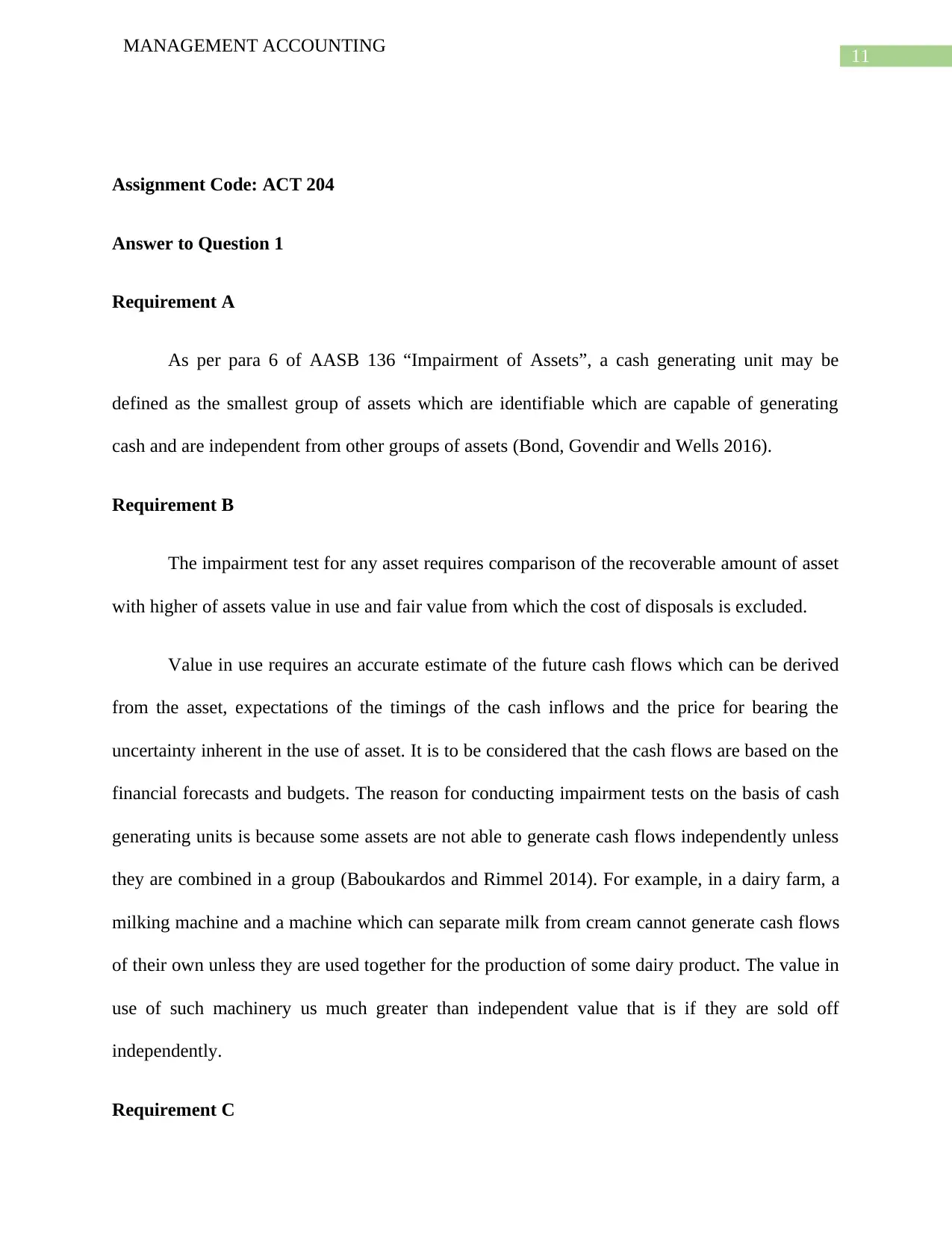
11
MANAGEMENT ACCOUNTING
Assignment Code: ACT 204
Answer to Question 1
Requirement A
As per para 6 of AASB 136 “Impairment of Assets”, a cash generating unit may be
defined as the smallest group of assets which are identifiable which are capable of generating
cash and are independent from other groups of assets (Bond, Govendir and Wells 2016).
Requirement B
The impairment test for any asset requires comparison of the recoverable amount of asset
with higher of assets value in use and fair value from which the cost of disposals is excluded.
Value in use requires an accurate estimate of the future cash flows which can be derived
from the asset, expectations of the timings of the cash inflows and the price for bearing the
uncertainty inherent in the use of asset. It is to be considered that the cash flows are based on the
financial forecasts and budgets. The reason for conducting impairment tests on the basis of cash
generating units is because some assets are not able to generate cash flows independently unless
they are combined in a group (Baboukardos and Rimmel 2014). For example, in a dairy farm, a
milking machine and a machine which can separate milk from cream cannot generate cash flows
of their own unless they are used together for the production of some dairy product. The value in
use of such machinery us much greater than independent value that is if they are sold off
independently.
Requirement C
MANAGEMENT ACCOUNTING
Assignment Code: ACT 204
Answer to Question 1
Requirement A
As per para 6 of AASB 136 “Impairment of Assets”, a cash generating unit may be
defined as the smallest group of assets which are identifiable which are capable of generating
cash and are independent from other groups of assets (Bond, Govendir and Wells 2016).
Requirement B
The impairment test for any asset requires comparison of the recoverable amount of asset
with higher of assets value in use and fair value from which the cost of disposals is excluded.
Value in use requires an accurate estimate of the future cash flows which can be derived
from the asset, expectations of the timings of the cash inflows and the price for bearing the
uncertainty inherent in the use of asset. It is to be considered that the cash flows are based on the
financial forecasts and budgets. The reason for conducting impairment tests on the basis of cash
generating units is because some assets are not able to generate cash flows independently unless
they are combined in a group (Baboukardos and Rimmel 2014). For example, in a dairy farm, a
milking machine and a machine which can separate milk from cream cannot generate cash flows
of their own unless they are used together for the production of some dairy product. The value in
use of such machinery us much greater than independent value that is if they are sold off
independently.
Requirement C
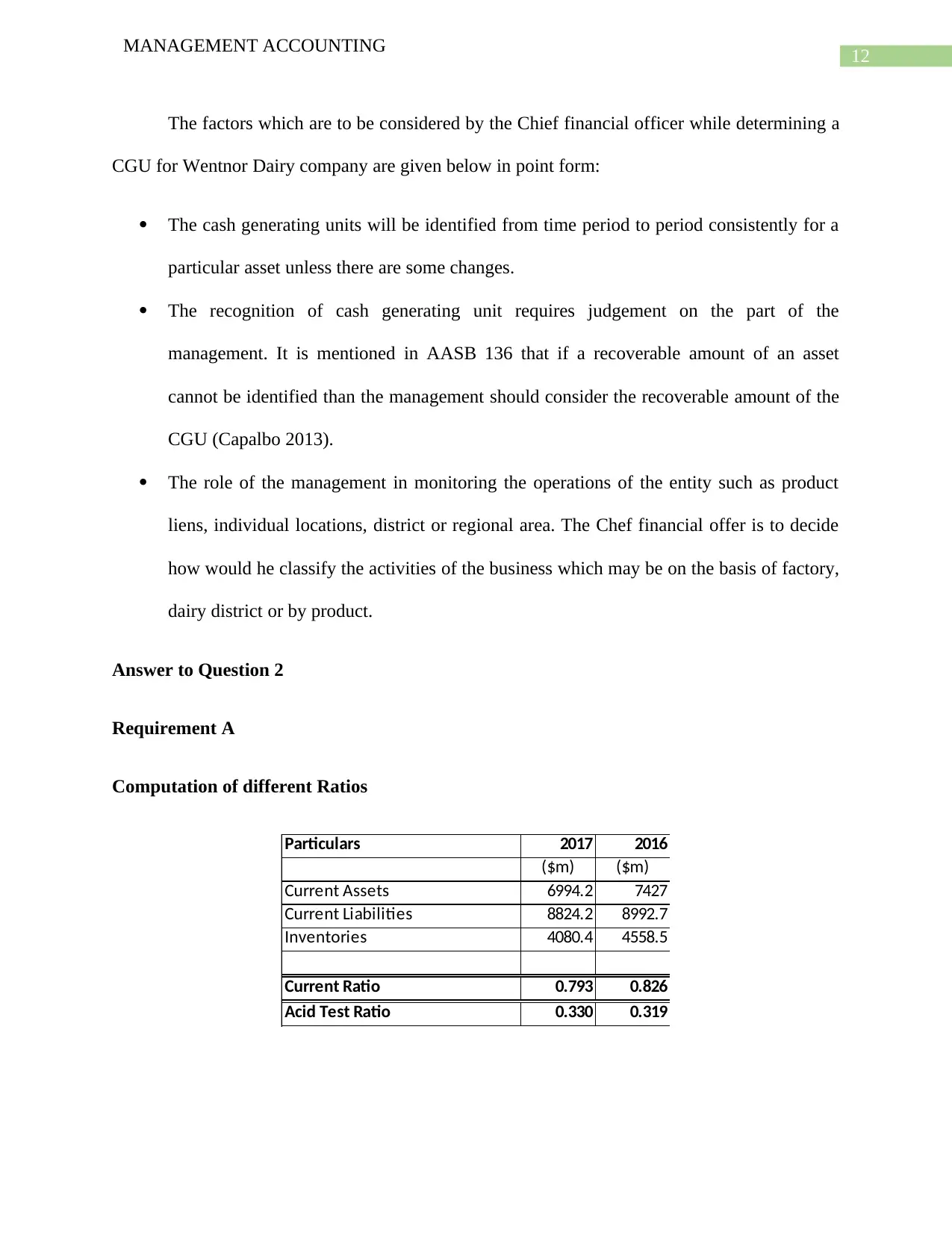
12
MANAGEMENT ACCOUNTING
The factors which are to be considered by the Chief financial officer while determining a
CGU for Wentnor Dairy company are given below in point form:
The cash generating units will be identified from time period to period consistently for a
particular asset unless there are some changes.
The recognition of cash generating unit requires judgement on the part of the
management. It is mentioned in AASB 136 that if a recoverable amount of an asset
cannot be identified than the management should consider the recoverable amount of the
CGU (Capalbo 2013).
The role of the management in monitoring the operations of the entity such as product
liens, individual locations, district or regional area. The Chef financial offer is to decide
how would he classify the activities of the business which may be on the basis of factory,
dairy district or by product.
Answer to Question 2
Requirement A
Computation of different Ratios
Particulars 2017 2016
($m) ($m)
Current Assets 6994.2 7427
Current Liabilities 8824.2 8992.7
Inventories 4080.4 4558.5
Current Ratio 0.793 0.826
Acid Test Ratio 0.330 0.319
MANAGEMENT ACCOUNTING
The factors which are to be considered by the Chief financial officer while determining a
CGU for Wentnor Dairy company are given below in point form:
The cash generating units will be identified from time period to period consistently for a
particular asset unless there are some changes.
The recognition of cash generating unit requires judgement on the part of the
management. It is mentioned in AASB 136 that if a recoverable amount of an asset
cannot be identified than the management should consider the recoverable amount of the
CGU (Capalbo 2013).
The role of the management in monitoring the operations of the entity such as product
liens, individual locations, district or regional area. The Chef financial offer is to decide
how would he classify the activities of the business which may be on the basis of factory,
dairy district or by product.
Answer to Question 2
Requirement A
Computation of different Ratios
Particulars 2017 2016
($m) ($m)
Current Assets 6994.2 7427
Current Liabilities 8824.2 8992.7
Inventories 4080.4 4558.5
Current Ratio 0.793 0.826
Acid Test Ratio 0.330 0.319
Paraphrase This Document
Need a fresh take? Get an instant paraphrase of this document with our AI Paraphraser
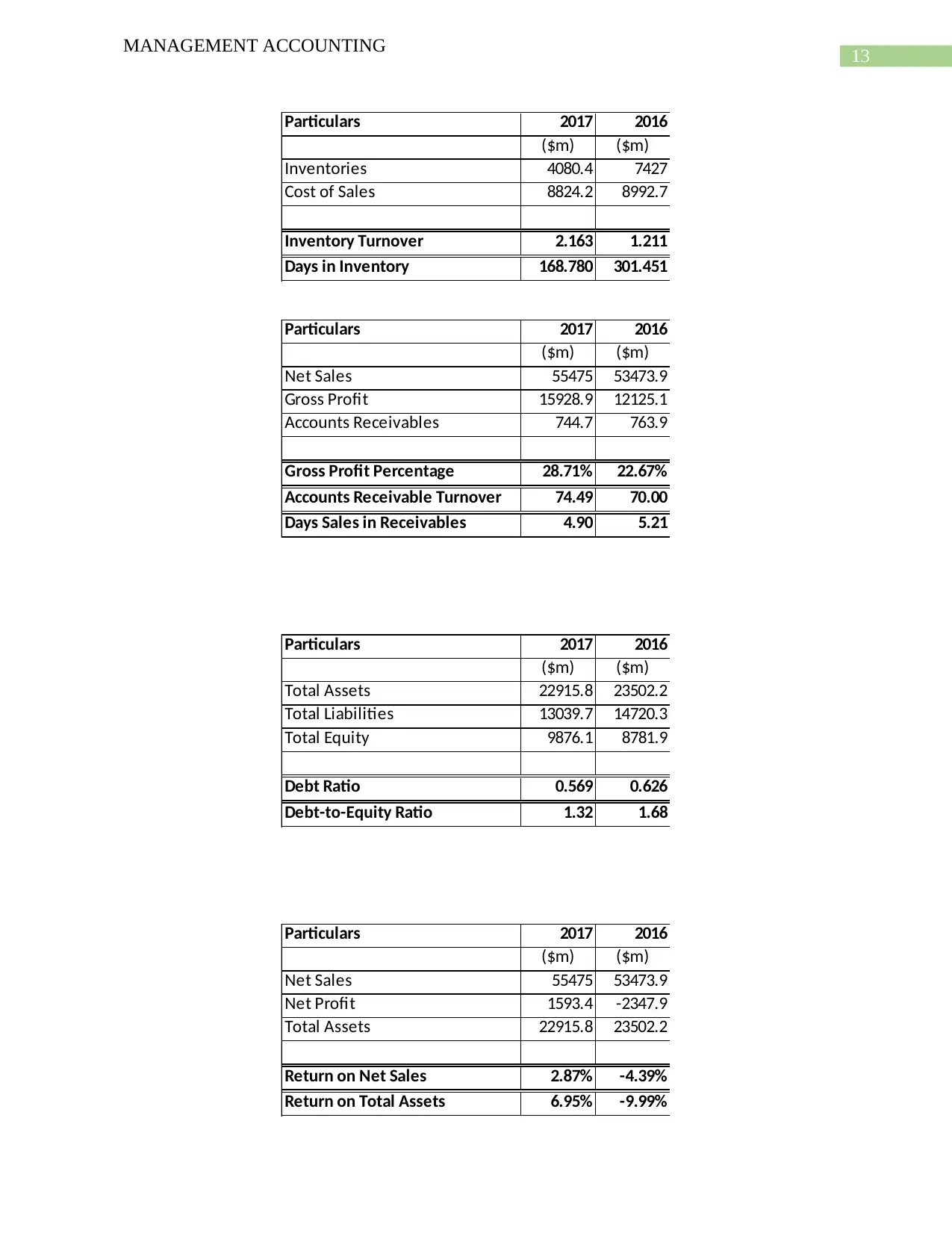
13
MANAGEMENT ACCOUNTING
Particulars 2017 2016
($m) ($m)
Inventories 4080.4 7427
Cost of Sales 8824.2 8992.7
Inventory Turnover 2.163 1.211
Days in Inventory 168.780 301.451
Particulars 2017 2016
($m) ($m)
Net Sales 55475 53473.9
Gross Profit 15928.9 12125.1
Accounts Receivables 744.7 763.9
Gross Profit Percentage 28.71% 22.67%
Accounts Receivable Turnover 74.49 70.00
Days Sales in Receivables 4.90 5.21
Particulars 2017 2016
($m) ($m)
Total Assets 22915.8 23502.2
Total Liabilities 13039.7 14720.3
Total Equity 9876.1 8781.9
Debt Ratio 0.569 0.626
Debt-to-Equity Ratio 1.32 1.68
Particulars 2017 2016
($m) ($m)
Net Sales 55475 53473.9
Net Profit 1593.4 -2347.9
Total Assets 22915.8 23502.2
Return on Net Sales 2.87% -4.39%
Return on Total Assets 6.95% -9.99%
MANAGEMENT ACCOUNTING
Particulars 2017 2016
($m) ($m)
Inventories 4080.4 7427
Cost of Sales 8824.2 8992.7
Inventory Turnover 2.163 1.211
Days in Inventory 168.780 301.451
Particulars 2017 2016
($m) ($m)
Net Sales 55475 53473.9
Gross Profit 15928.9 12125.1
Accounts Receivables 744.7 763.9
Gross Profit Percentage 28.71% 22.67%
Accounts Receivable Turnover 74.49 70.00
Days Sales in Receivables 4.90 5.21
Particulars 2017 2016
($m) ($m)
Total Assets 22915.8 23502.2
Total Liabilities 13039.7 14720.3
Total Equity 9876.1 8781.9
Debt Ratio 0.569 0.626
Debt-to-Equity Ratio 1.32 1.68
Particulars 2017 2016
($m) ($m)
Net Sales 55475 53473.9
Net Profit 1593.4 -2347.9
Total Assets 22915.8 23502.2
Return on Net Sales 2.87% -4.39%
Return on Total Assets 6.95% -9.99%
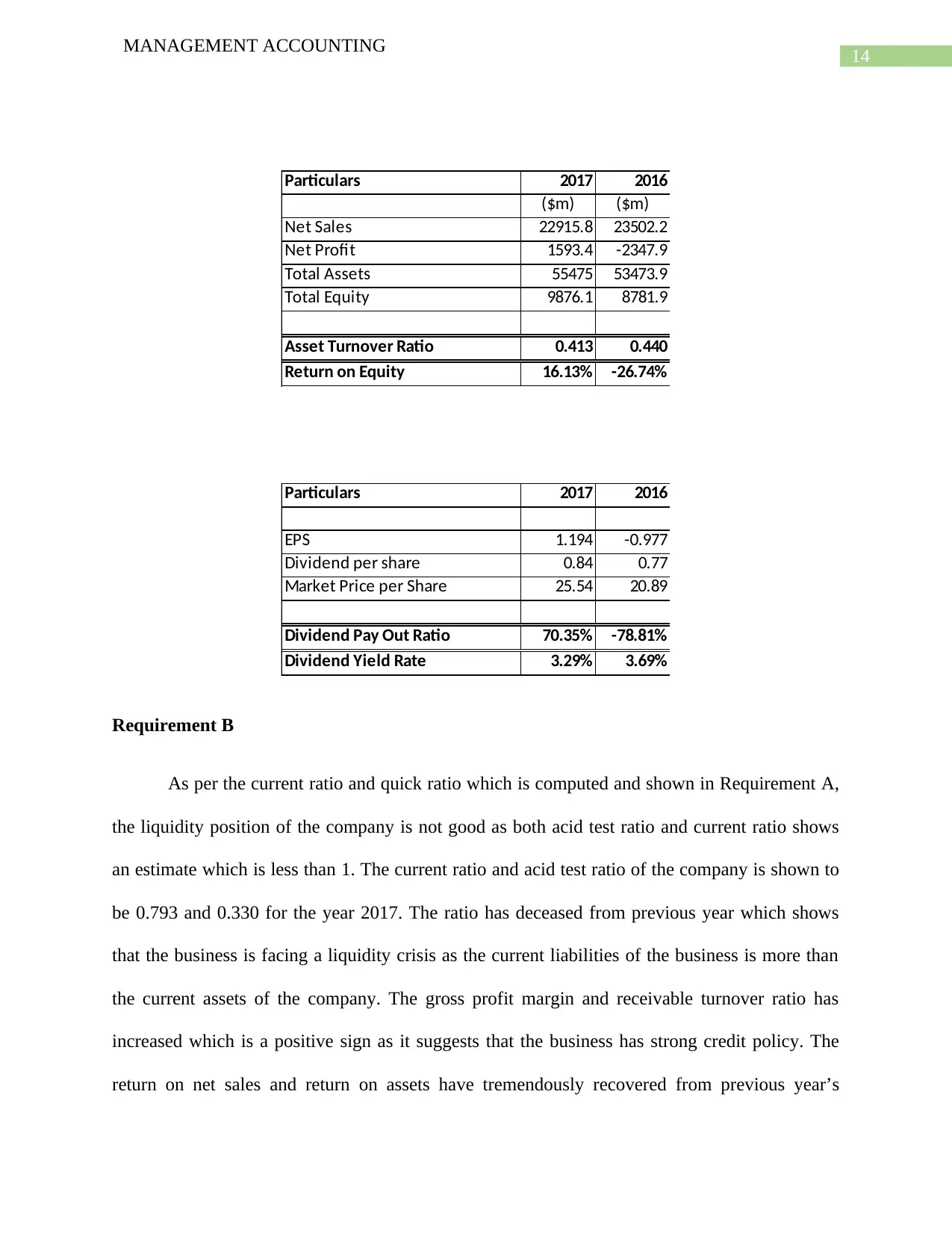
14
MANAGEMENT ACCOUNTING
Particulars 2017 2016
($m) ($m)
Net Sales 22915.8 23502.2
Net Profit 1593.4 -2347.9
Total Assets 55475 53473.9
Total Equity 9876.1 8781.9
Asset Turnover Ratio 0.413 0.440
Return on Equity 16.13% -26.74%
Particulars 2017 2016
EPS 1.194 -0.977
Dividend per share 0.84 0.77
Market Price per Share 25.54 20.89
Dividend Pay Out Ratio 70.35% -78.81%
Dividend Yield Rate 3.29% 3.69%
Requirement B
As per the current ratio and quick ratio which is computed and shown in Requirement A,
the liquidity position of the company is not good as both acid test ratio and current ratio shows
an estimate which is less than 1. The current ratio and acid test ratio of the company is shown to
be 0.793 and 0.330 for the year 2017. The ratio has deceased from previous year which shows
that the business is facing a liquidity crisis as the current liabilities of the business is more than
the current assets of the company. The gross profit margin and receivable turnover ratio has
increased which is a positive sign as it suggests that the business has strong credit policy. The
return on net sales and return on assets have tremendously recovered from previous year’s
MANAGEMENT ACCOUNTING
Particulars 2017 2016
($m) ($m)
Net Sales 22915.8 23502.2
Net Profit 1593.4 -2347.9
Total Assets 55475 53473.9
Total Equity 9876.1 8781.9
Asset Turnover Ratio 0.413 0.440
Return on Equity 16.13% -26.74%
Particulars 2017 2016
EPS 1.194 -0.977
Dividend per share 0.84 0.77
Market Price per Share 25.54 20.89
Dividend Pay Out Ratio 70.35% -78.81%
Dividend Yield Rate 3.29% 3.69%
Requirement B
As per the current ratio and quick ratio which is computed and shown in Requirement A,
the liquidity position of the company is not good as both acid test ratio and current ratio shows
an estimate which is less than 1. The current ratio and acid test ratio of the company is shown to
be 0.793 and 0.330 for the year 2017. The ratio has deceased from previous year which shows
that the business is facing a liquidity crisis as the current liabilities of the business is more than
the current assets of the company. The gross profit margin and receivable turnover ratio has
increased which is a positive sign as it suggests that the business has strong credit policy. The
return on net sales and return on assets have tremendously recovered from previous year’s

15
MANAGEMENT ACCOUNTING
estimate which suggest that the business has recovered from negative returns to appropriate and
favorable returns. The return on equity also shows favorable result for the year 2017 which
signifies that the business meets the need of the shareholders effectively. Thus, from the above
discussions it is clear that the business is favorable for making investments and the investor
should invest in the shares of the company (Al Karim and Alam 2013). The company however
needs to maintain and improve the liquidity position of the company and thereby ensure that the
business does not face any liquidity crisis. Thus, it can be said the investor should invest in the
shares of the company.
Requirement C
As per the computation of ratios which is shown in Requirement A, the current ratio and
the acid test ratio of the company shows that the business does not have favorable ratio for the
year 2017 which is shown as 0.793 and 0.330 respectively. The ratio does not match to the
standard which is considered to be ideal estimates which suggests that the business might be
facing liquidity problems (Delen, Kuzey and Uyar 2013).
Answer to Question 3
As per the para which is provided in the question, deals with the translation of foreign
currency in Australian dollars. The paragraph signifies that Qantas limited has engaged in
foreign trade during the year and thus in order to record the income the business needs to convert
the amount of foreign currency in Australian dollars (Machlup 2013). The most used technique
which is used for the purpose of translation is current rate method which is applied by most of
the companies (Pym 2014).
MANAGEMENT ACCOUNTING
estimate which suggest that the business has recovered from negative returns to appropriate and
favorable returns. The return on equity also shows favorable result for the year 2017 which
signifies that the business meets the need of the shareholders effectively. Thus, from the above
discussions it is clear that the business is favorable for making investments and the investor
should invest in the shares of the company (Al Karim and Alam 2013). The company however
needs to maintain and improve the liquidity position of the company and thereby ensure that the
business does not face any liquidity crisis. Thus, it can be said the investor should invest in the
shares of the company.
Requirement C
As per the computation of ratios which is shown in Requirement A, the current ratio and
the acid test ratio of the company shows that the business does not have favorable ratio for the
year 2017 which is shown as 0.793 and 0.330 respectively. The ratio does not match to the
standard which is considered to be ideal estimates which suggests that the business might be
facing liquidity problems (Delen, Kuzey and Uyar 2013).
Answer to Question 3
As per the para which is provided in the question, deals with the translation of foreign
currency in Australian dollars. The paragraph signifies that Qantas limited has engaged in
foreign trade during the year and thus in order to record the income the business needs to convert
the amount of foreign currency in Australian dollars (Machlup 2013). The most used technique
which is used for the purpose of translation is current rate method which is applied by most of
the companies (Pym 2014).
Secure Best Marks with AI Grader
Need help grading? Try our AI Grader for instant feedback on your assignments.
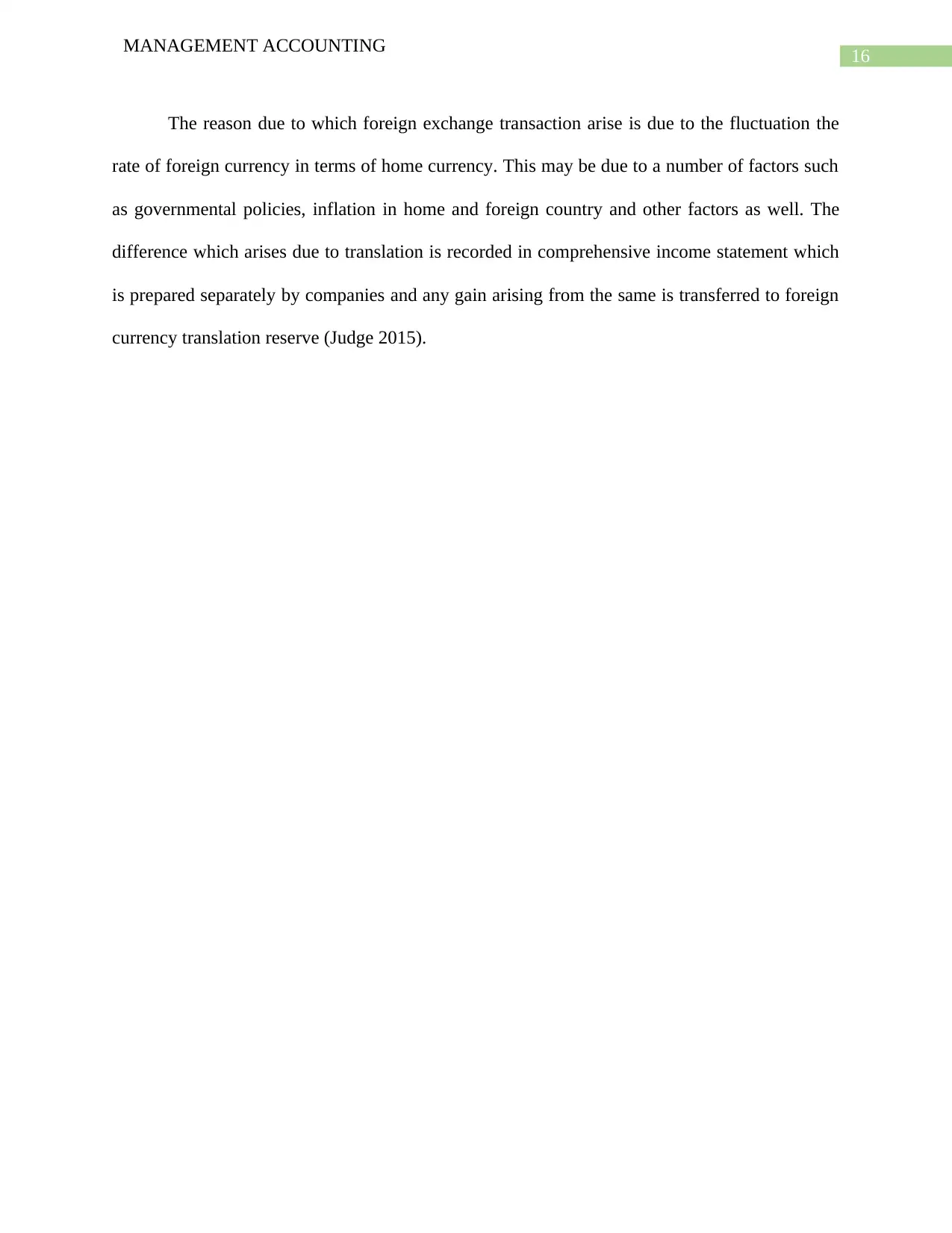
16
MANAGEMENT ACCOUNTING
The reason due to which foreign exchange transaction arise is due to the fluctuation the
rate of foreign currency in terms of home currency. This may be due to a number of factors such
as governmental policies, inflation in home and foreign country and other factors as well. The
difference which arises due to translation is recorded in comprehensive income statement which
is prepared separately by companies and any gain arising from the same is transferred to foreign
currency translation reserve (Judge 2015).
MANAGEMENT ACCOUNTING
The reason due to which foreign exchange transaction arise is due to the fluctuation the
rate of foreign currency in terms of home currency. This may be due to a number of factors such
as governmental policies, inflation in home and foreign country and other factors as well. The
difference which arises due to translation is recorded in comprehensive income statement which
is prepared separately by companies and any gain arising from the same is transferred to foreign
currency translation reserve (Judge 2015).
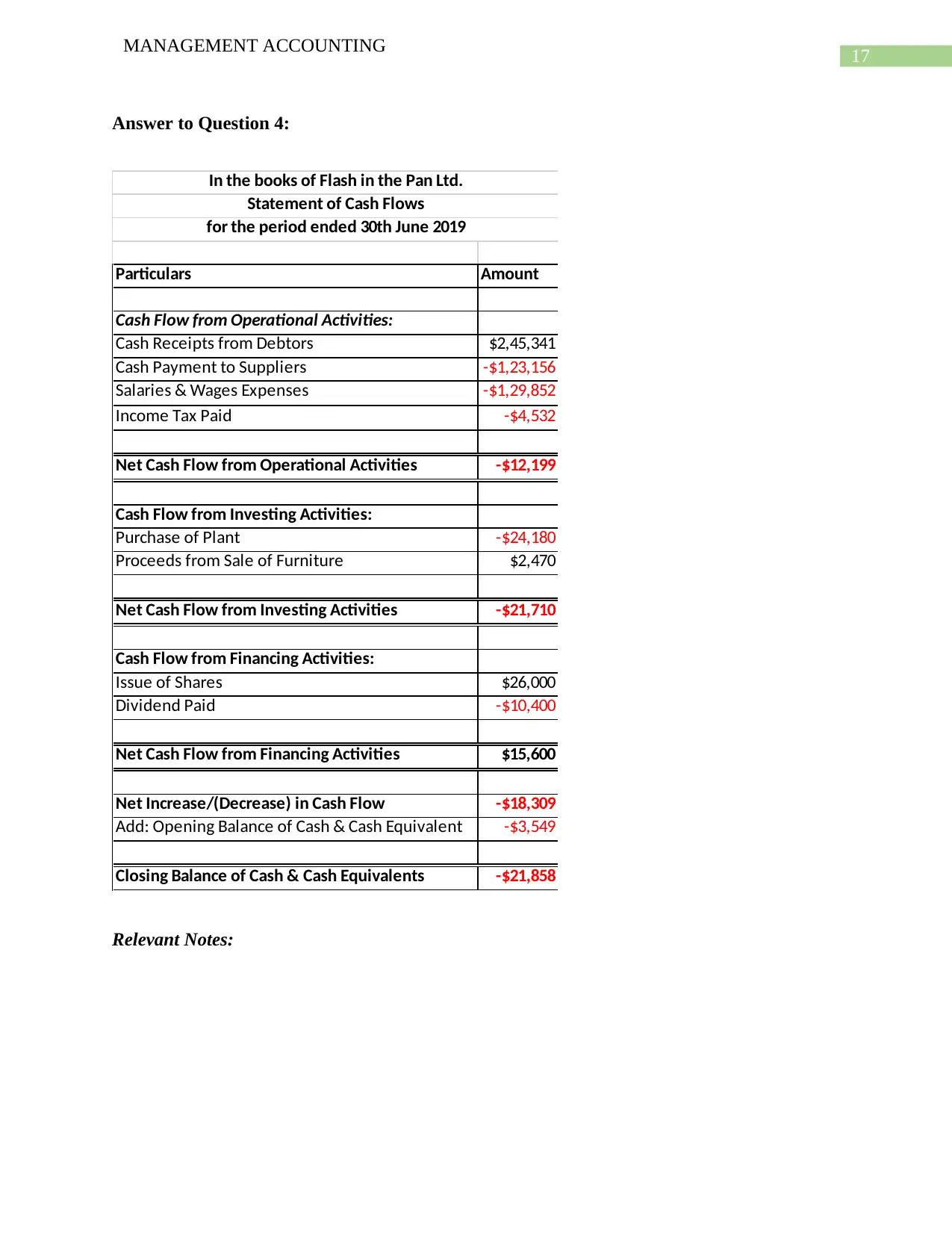
17
MANAGEMENT ACCOUNTING
Answer to Question 4:
Particulars Amount
Cash Flow from Operational Activities:
Cash Receipts from Debtors $2,45,341
Cash Payment to Suppliers -$1,23,156
Salaries & Wages Expenses -$1,29,852
Income Tax Paid -$4,532
Net Cash Flow from Operational Activities -$12,199
Cash Flow from Investing Activities:
Purchase of Plant -$24,180
Proceeds from Sale of Furniture $2,470
Net Cash Flow from Investing Activities -$21,710
Cash Flow from Financing Activities:
Issue of Shares $26,000
Dividend Paid -$10,400
Net Cash Flow from Financing Activities $15,600
Net Increase/(Decrease) in Cash Flow -$18,309
Add: Opening Balance of Cash & Cash Equivalent -$3,549
Closing Balance of Cash & Cash Equivalents -$21,858
In the books of Flash in the Pan Ltd.
Statement of Cash Flows
for the period ended 30th June 2019
Relevant Notes:
MANAGEMENT ACCOUNTING
Answer to Question 4:
Particulars Amount
Cash Flow from Operational Activities:
Cash Receipts from Debtors $2,45,341
Cash Payment to Suppliers -$1,23,156
Salaries & Wages Expenses -$1,29,852
Income Tax Paid -$4,532
Net Cash Flow from Operational Activities -$12,199
Cash Flow from Investing Activities:
Purchase of Plant -$24,180
Proceeds from Sale of Furniture $2,470
Net Cash Flow from Investing Activities -$21,710
Cash Flow from Financing Activities:
Issue of Shares $26,000
Dividend Paid -$10,400
Net Cash Flow from Financing Activities $15,600
Net Increase/(Decrease) in Cash Flow -$18,309
Add: Opening Balance of Cash & Cash Equivalent -$3,549
Closing Balance of Cash & Cash Equivalents -$21,858
In the books of Flash in the Pan Ltd.
Statement of Cash Flows
for the period ended 30th June 2019
Relevant Notes:

18
MANAGEMENT ACCOUNTING
Particulars Amount
Sales Revenue $2,60,000
Cost of Sales -$91,000
Gross Profit $1,69,000
Salaries & Wages Expenses -$1,29,852
Additional Bad Debts -$3,120
Doubtful Debts Expense -$4,420
Depreciation expense -$7,995
Net Operating Profit $23,613
Gain on Sale of Furniture $130
Net Profit before tax $23,743
Income Tax Expense -$7,132
Net Profit for the Period $16,611
In the books of Flash in the Pan Ltd.
Income Statement
as on 30th June 2019
MANAGEMENT ACCOUNTING
Particulars Amount
Sales Revenue $2,60,000
Cost of Sales -$91,000
Gross Profit $1,69,000
Salaries & Wages Expenses -$1,29,852
Additional Bad Debts -$3,120
Doubtful Debts Expense -$4,420
Depreciation expense -$7,995
Net Operating Profit $23,613
Gain on Sale of Furniture $130
Net Profit before tax $23,743
Income Tax Expense -$7,132
Net Profit for the Period $16,611
In the books of Flash in the Pan Ltd.
Income Statement
as on 30th June 2019
Paraphrase This Document
Need a fresh take? Get an instant paraphrase of this document with our AI Paraphraser

19
MANAGEMENT ACCOUNTING
Particulars Amount
Cash Flow from Operational Activities:
Net Profit for the period $16,611
Depreciation Expenses $7,995
Doubtful Debt Expenses $4,420
Gain on Sale of Furniture -$130
Increase in Accounts Receivable -$11,539
Increase in Inventory -$31,280
Decrease in Accounts Payable -$876
Increase in Current Tax Liability $2,600
Net Cash Flow from Operational Activity -$12,199
Cash Flow from Investing Activities:
Purchase of Plant -$24,180
Proceeds from Sale of Furniture $2,470
Net Cash Flow from Investing Activities -$21,710
Cash Flow from Financing Activities:
Issue of Shares $26,000
Dividend Paid -$10,400
Net Cash Flow from Financing Activities $15,600
Net Increase/(Decrease) in Cash Flow -$18,309
Add: Opening Balance of Cash & Cash Equivalent -$3,549
Closing Balance of Cash & Cash Equivalents -$21,858
In the books of Flash in the Pan Ltd.
Statement of Cash Flows (Indirect Method)
for the period ended 30th June 2019
MANAGEMENT ACCOUNTING
Particulars Amount
Cash Flow from Operational Activities:
Net Profit for the period $16,611
Depreciation Expenses $7,995
Doubtful Debt Expenses $4,420
Gain on Sale of Furniture -$130
Increase in Accounts Receivable -$11,539
Increase in Inventory -$31,280
Decrease in Accounts Payable -$876
Increase in Current Tax Liability $2,600
Net Cash Flow from Operational Activity -$12,199
Cash Flow from Investing Activities:
Purchase of Plant -$24,180
Proceeds from Sale of Furniture $2,470
Net Cash Flow from Investing Activities -$21,710
Cash Flow from Financing Activities:
Issue of Shares $26,000
Dividend Paid -$10,400
Net Cash Flow from Financing Activities $15,600
Net Increase/(Decrease) in Cash Flow -$18,309
Add: Opening Balance of Cash & Cash Equivalent -$3,549
Closing Balance of Cash & Cash Equivalents -$21,858
In the books of Flash in the Pan Ltd.
Statement of Cash Flows (Indirect Method)
for the period ended 30th June 2019
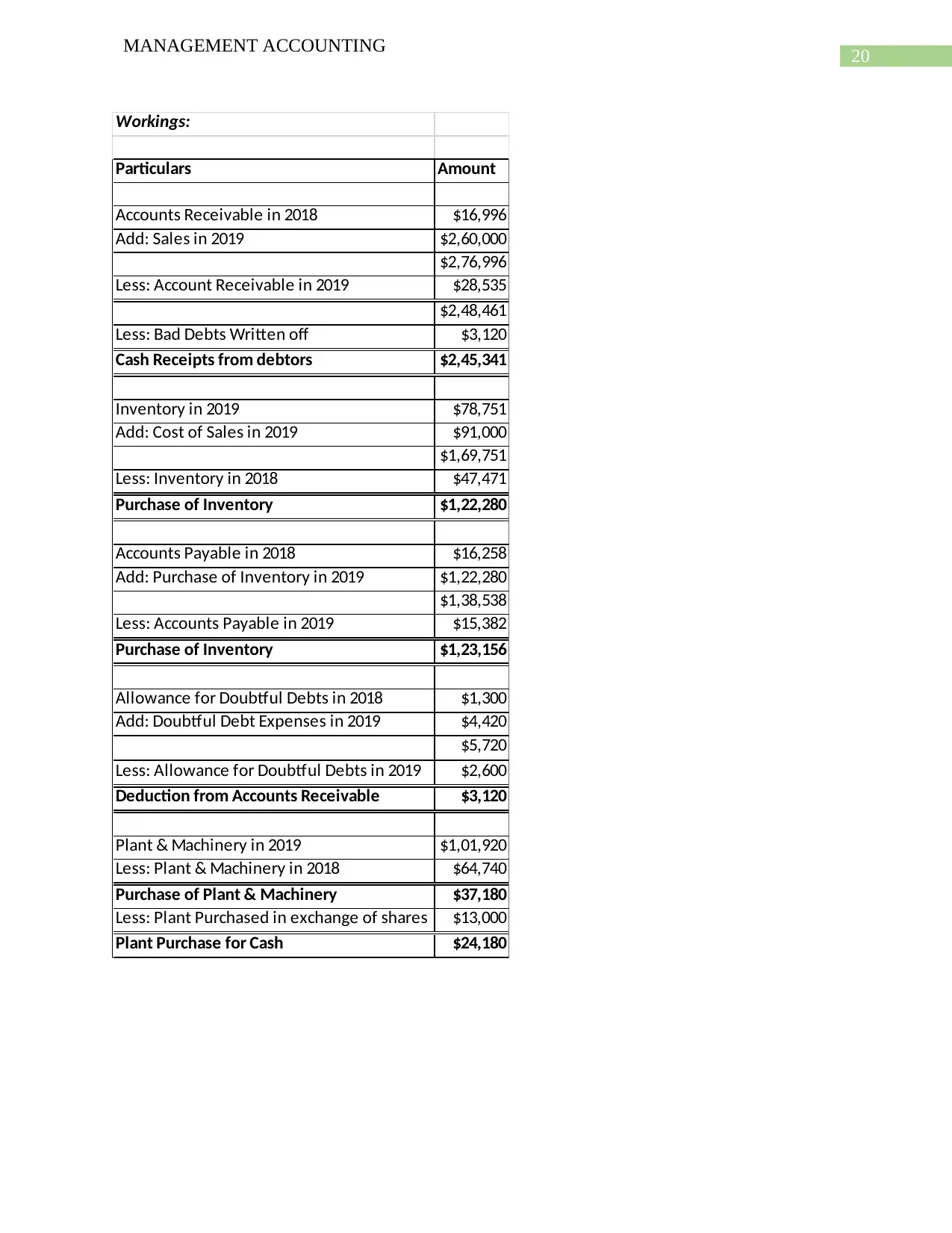
20
MANAGEMENT ACCOUNTING
Workings:
Particulars Amount
Accounts Receivable in 2018 $16,996
Add: Sales in 2019 $2,60,000
$2,76,996
Less: Account Receivable in 2019 $28,535
$2,48,461
Less: Bad Debts Written off $3,120
Cash Receipts from debtors $2,45,341
Inventory in 2019 $78,751
Add: Cost of Sales in 2019 $91,000
$1,69,751
Less: Inventory in 2018 $47,471
Purchase of Inventory $1,22,280
Accounts Payable in 2018 $16,258
Add: Purchase of Inventory in 2019 $1,22,280
$1,38,538
Less: Accounts Payable in 2019 $15,382
Purchase of Inventory $1,23,156
Allowance for Doubtful Debts in 2018 $1,300
Add: Doubtful Debt Expenses in 2019 $4,420
$5,720
Less: Allowance for Doubtful Debts in 2019 $2,600
Deduction from Accounts Receivable $3,120
Plant & Machinery in 2019 $1,01,920
Less: Plant & Machinery in 2018 $64,740
Purchase of Plant & Machinery $37,180
Less: Plant Purchased in exchange of shares $13,000
Plant Purchase for Cash $24,180
MANAGEMENT ACCOUNTING
Workings:
Particulars Amount
Accounts Receivable in 2018 $16,996
Add: Sales in 2019 $2,60,000
$2,76,996
Less: Account Receivable in 2019 $28,535
$2,48,461
Less: Bad Debts Written off $3,120
Cash Receipts from debtors $2,45,341
Inventory in 2019 $78,751
Add: Cost of Sales in 2019 $91,000
$1,69,751
Less: Inventory in 2018 $47,471
Purchase of Inventory $1,22,280
Accounts Payable in 2018 $16,258
Add: Purchase of Inventory in 2019 $1,22,280
$1,38,538
Less: Accounts Payable in 2019 $15,382
Purchase of Inventory $1,23,156
Allowance for Doubtful Debts in 2018 $1,300
Add: Doubtful Debt Expenses in 2019 $4,420
$5,720
Less: Allowance for Doubtful Debts in 2019 $2,600
Deduction from Accounts Receivable $3,120
Plant & Machinery in 2019 $1,01,920
Less: Plant & Machinery in 2018 $64,740
Purchase of Plant & Machinery $37,180
Less: Plant Purchased in exchange of shares $13,000
Plant Purchase for Cash $24,180
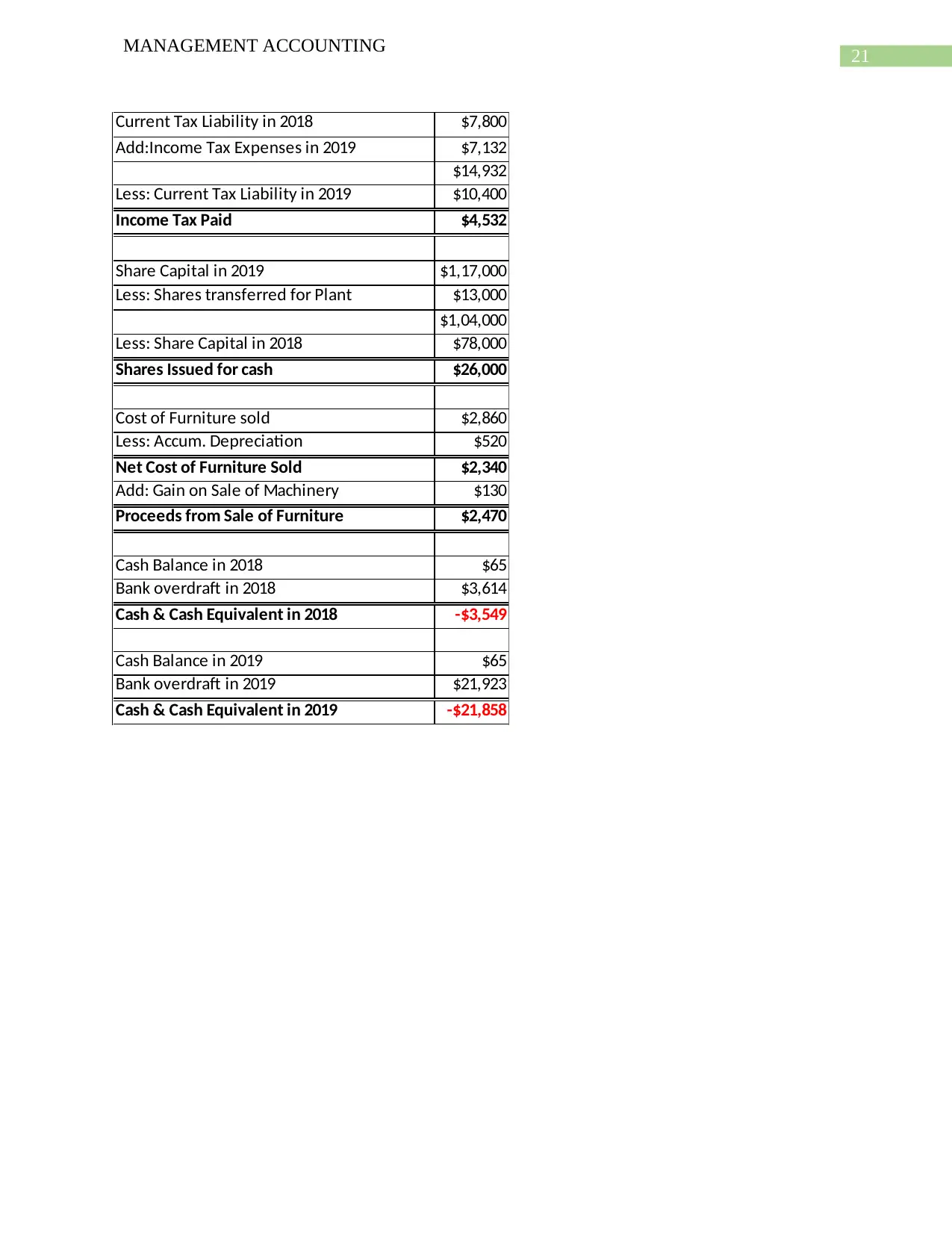
21
MANAGEMENT ACCOUNTING
Current Tax Liability in 2018 $7,800
Add:Income Tax Expenses in 2019 $7,132
$14,932
Less: Current Tax Liability in 2019 $10,400
Income Tax Paid $4,532
Share Capital in 2019 $1,17,000
Less: Shares transferred for Plant $13,000
$1,04,000
Less: Share Capital in 2018 $78,000
Shares Issued for cash $26,000
Cost of Furniture sold $2,860
Less: Accum. Depreciation $520
Net Cost of Furniture Sold $2,340
Add: Gain on Sale of Machinery $130
Proceeds from Sale of Furniture $2,470
Cash Balance in 2018 $65
Bank overdraft in 2018 $3,614
Cash & Cash Equivalent in 2018 -$3,549
Cash Balance in 2019 $65
Bank overdraft in 2019 $21,923
Cash & Cash Equivalent in 2019 -$21,858
MANAGEMENT ACCOUNTING
Current Tax Liability in 2018 $7,800
Add:Income Tax Expenses in 2019 $7,132
$14,932
Less: Current Tax Liability in 2019 $10,400
Income Tax Paid $4,532
Share Capital in 2019 $1,17,000
Less: Shares transferred for Plant $13,000
$1,04,000
Less: Share Capital in 2018 $78,000
Shares Issued for cash $26,000
Cost of Furniture sold $2,860
Less: Accum. Depreciation $520
Net Cost of Furniture Sold $2,340
Add: Gain on Sale of Machinery $130
Proceeds from Sale of Furniture $2,470
Cash Balance in 2018 $65
Bank overdraft in 2018 $3,614
Cash & Cash Equivalent in 2018 -$3,549
Cash Balance in 2019 $65
Bank overdraft in 2019 $21,923
Cash & Cash Equivalent in 2019 -$21,858
Secure Best Marks with AI Grader
Need help grading? Try our AI Grader for instant feedback on your assignments.
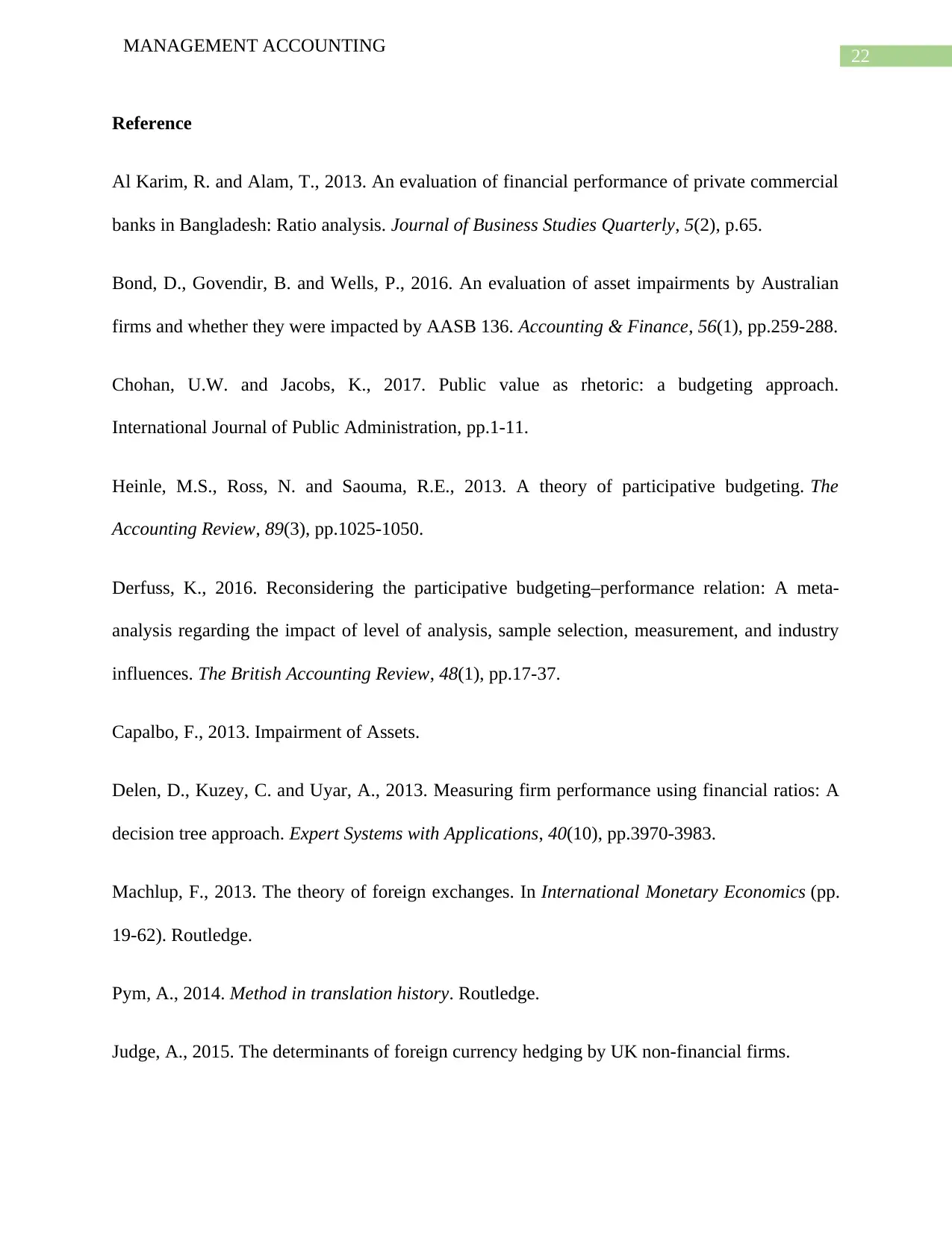
22
MANAGEMENT ACCOUNTING
Reference
Al Karim, R. and Alam, T., 2013. An evaluation of financial performance of private commercial
banks in Bangladesh: Ratio analysis. Journal of Business Studies Quarterly, 5(2), p.65.
Bond, D., Govendir, B. and Wells, P., 2016. An evaluation of asset impairments by Australian
firms and whether they were impacted by AASB 136. Accounting & Finance, 56(1), pp.259-288.
Chohan, U.W. and Jacobs, K., 2017. Public value as rhetoric: a budgeting approach.
International Journal of Public Administration, pp.1-11.
Heinle, M.S., Ross, N. and Saouma, R.E., 2013. A theory of participative budgeting. The
Accounting Review, 89(3), pp.1025-1050.
Derfuss, K., 2016. Reconsidering the participative budgeting–performance relation: A meta-
analysis regarding the impact of level of analysis, sample selection, measurement, and industry
influences. The British Accounting Review, 48(1), pp.17-37.
Capalbo, F., 2013. Impairment of Assets.
Delen, D., Kuzey, C. and Uyar, A., 2013. Measuring firm performance using financial ratios: A
decision tree approach. Expert Systems with Applications, 40(10), pp.3970-3983.
Machlup, F., 2013. The theory of foreign exchanges. In International Monetary Economics (pp.
19-62). Routledge.
Pym, A., 2014. Method in translation history. Routledge.
Judge, A., 2015. The determinants of foreign currency hedging by UK non-financial firms.
MANAGEMENT ACCOUNTING
Reference
Al Karim, R. and Alam, T., 2013. An evaluation of financial performance of private commercial
banks in Bangladesh: Ratio analysis. Journal of Business Studies Quarterly, 5(2), p.65.
Bond, D., Govendir, B. and Wells, P., 2016. An evaluation of asset impairments by Australian
firms and whether they were impacted by AASB 136. Accounting & Finance, 56(1), pp.259-288.
Chohan, U.W. and Jacobs, K., 2017. Public value as rhetoric: a budgeting approach.
International Journal of Public Administration, pp.1-11.
Heinle, M.S., Ross, N. and Saouma, R.E., 2013. A theory of participative budgeting. The
Accounting Review, 89(3), pp.1025-1050.
Derfuss, K., 2016. Reconsidering the participative budgeting–performance relation: A meta-
analysis regarding the impact of level of analysis, sample selection, measurement, and industry
influences. The British Accounting Review, 48(1), pp.17-37.
Capalbo, F., 2013. Impairment of Assets.
Delen, D., Kuzey, C. and Uyar, A., 2013. Measuring firm performance using financial ratios: A
decision tree approach. Expert Systems with Applications, 40(10), pp.3970-3983.
Machlup, F., 2013. The theory of foreign exchanges. In International Monetary Economics (pp.
19-62). Routledge.
Pym, A., 2014. Method in translation history. Routledge.
Judge, A., 2015. The determinants of foreign currency hedging by UK non-financial firms.
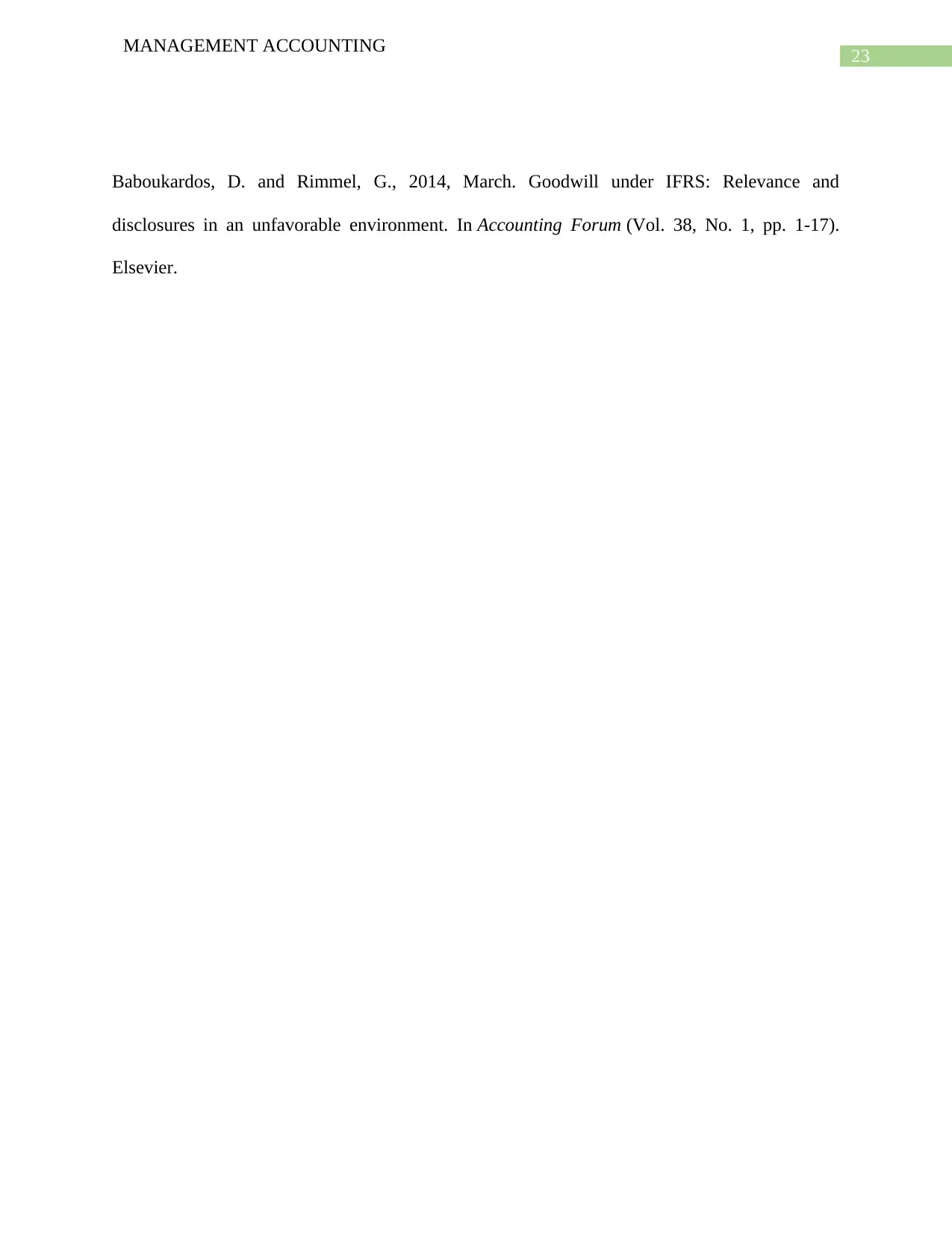
23
MANAGEMENT ACCOUNTING
Baboukardos, D. and Rimmel, G., 2014, March. Goodwill under IFRS: Relevance and
disclosures in an unfavorable environment. In Accounting Forum (Vol. 38, No. 1, pp. 1-17).
Elsevier.
MANAGEMENT ACCOUNTING
Baboukardos, D. and Rimmel, G., 2014, March. Goodwill under IFRS: Relevance and
disclosures in an unfavorable environment. In Accounting Forum (Vol. 38, No. 1, pp. 1-17).
Elsevier.
1 out of 24
Related Documents
Your All-in-One AI-Powered Toolkit for Academic Success.
+13062052269
info@desklib.com
Available 24*7 on WhatsApp / Email
![[object Object]](/_next/static/media/star-bottom.7253800d.svg)
Unlock your academic potential
© 2024 | Zucol Services PVT LTD | All rights reserved.





